Gamal Abdel Nasser
Gamal Abdel Nasser جمال عبد الناصر | |
|---|---|
 | |
| President of the United Arab Republic formerly President of the Republic of Egypt | |
| In office 23 June 1956 – 28 September 1970 | |
| Prime Minister | See list |
| Vice President | |
| Preceded by | Muhammad Naguib |
| Succeeded by | Anwar Sadat |
| Prime Minister of Egypt | |
| In office 19 June 1967 – 28 September 1970 | |
| President | Himself |
| Preceded by | Muhammad Sedki Sulayman |
| Succeeded by | Mahmoud Fawzi |
| In office 18 April 1954 – 29 September 1962 | |
| President | Muhammad Naguib Himself |
| Preceded by | Muhammad Naguib |
| Succeeded by | Ali Sabri |
| In office 25 February 1954 – 8 March 1954 | |
| President | Muhammad Naguib |
| Preceded by | Muhammad Naguib |
| Succeeded by | Muhammad Naguib |
| Deputy Prime Minister of Egypt | |
| In office 8 March 1954 – 18 April 1954 | |
| Prime Minister | Muhammad Naguib |
| Preceded by | Gamal Salem |
| Succeeded by | Gamal Salem |
| In office 18 June 1953 – 25 February 1954 | |
| Prime Minister | Muhammad Naguib |
| Preceded by | Sulayman Hafez |
| Succeeded by | Gamal Salem |
| Minister of the Interior | |
| In office 18 June 1953 – 25 February 1954 | |
| Prime Minister | Muhammad Naguib |
| Preceded by | Sulayman Hafez |
| Succeeded by | Zakaria Mohieddin |
| Chairman of the Revolutionary Command Council | |
| In office 14 November 1954 – 23 June 1956 | |
| Preceded by | Muhammad Naguib |
| Succeeded by | Post abolished |
| Secretary General of the Non-Aligned Movement | |
| In office 5 October 1964 – 8 September 1970 | |
| Preceded by | Josip Broz Tito |
| Succeeded by | Kenneth Kaunda |
| Chairman of the Organisation of African Unity | |
| In office 17 July 1964 – 21 October 1965 | |
| Preceded by | Haile Selassie I |
| Succeeded by | Kwame Nkrumah |
| Personal details | |
| Born | Gamal Abdel Nasser Hussein 15 January 1918 Alexandria, Sultanate of Egypt |
| Died | 28 September 1970 (aged 52) Cairo, Egypt |
| Political party | Arab Socialist Union |
| Spouse | Tahia Kazem |
| Children | Hoda Mona Khalid Abdel Hamid Abdel Hakim |
| Signature | |
| Military service | |
| Allegiance | |
| Branch/service | |
| Years of service | 1938–1952 |
| Rank | |
| Battles/wars | 1948 Arab–Israeli War |
Gamal Abdel Nasser Hussein (Arabic: جمال عبد الناصر حسين, IPA: [ɡæˈmæːl ʕæbdenˈnɑːsˤeɾ ħeˈseːn]; 15 January 1918 – 28 September 1970) was the second President of Egypt from 1956 until his death. Nasser planned the 1952 overthrow of the monarchy, and served as deputy prime minister in the new government. In 1953, Nasser introduced far-reaching land reforms and following a 1954 Muslim Brotherhood-led assassination attempt on his life, he ordered a crackdown against the organization, put President Muhammad Naguib under house arrest, and assumed executive office. A June 1956 public referendum approved both the new constitution and Nasser's nomination for presidency.
Nasser's neutralist policies during the Cold War led to tense relations with Western powers, who withdrew funding for the planned Aswan Dam. Nasser's retaliatory move to nationalize the Suez Canal Company in 1956 was acclaimed within Egypt and the Arab world. Britain, France, and Israel invaded Sinai in the Suez Crisis, but withdrew amid international pressure and boosted Nasser's political standing significantly. From then onward, Nasser's popularity in the region grew substantially and calls for pan-Arab unity under his leadership increased, culminating with the formation of the United Arab Republic with Syria (1958–1961).
In 1962, Nasser began a series of major socialist measures and modernization reforms in Egypt. Despite setbacks to his pan-Arabist cause, by 1963, Nasser's supporters gained power in several Arab countries. He also became embroiled in the North Yemen Civil War at this time. Nasser introduced a new constitution in 1964, the same year he became president of the international Non-Aligned Movement. Nasser began his second presidential term in March 1965 after running unopposed, his political opponents legally forbidden from competing. Following Egypt's concessions to Israel in the 1967 Six-Day War, Nasser resigned only to renege after popular demonstrations called for his reinstatement. Between the 1967 defeat and 1968, Nasser appointed himself prime minister, launched a war to regain lost territory, began a process of depoliticizing the military, and promised political liberalization reforms.
After the conclusion of the 1970 Arab League summit, Nasser suffered a heart attack and died. His funeral in Cairo drew five million mourners and an outpouring of grief across the Arab world. Nasser remains an iconic figure and symbol of Arab dignity in the present day, especially for his strides towards social justice and Arab unity, modernization policies, and anti-imperialist efforts. His presidency also encouraged and coincided with an Egyptian cultural boom, particularly in the arts. Nasser's detractors criticized his authoritarianism, his government's human rights violations, his populist relationship with the citizenry, and his failure to establish durable civil institutions. Historians describe Nasser as one of the towering political figures of modern Middle East history and politics in the 20th century.
Early life

Gamal Abdel Nasser was born on 15 January 1918 in Bakos, Alexandria, Egypt as Fahima and Abdel Nasser Hussein's first son.[1] His father was a postal worker[2] born in Beni Mur in Upper Egypt and raised in Alexandria,[1] and his mother's family came from Mallawi, el-Minya.[3] His parents married in 1917,[3] and later had two more boys, Izz al-Arab and al-Leithi.[1] Nasser's biographers Robert Stephens and Said Aburish wrote that Nasser's family believed strongly in the "Arab notion of glory", since the name of Nasser's brother, Izz al-Arab, translates to "Glory of the Arabs"—a rare occurrence in Egypt.[4]
The family traveled frequently due to his father's work. In 1921, they moved to Asyut and in 1923, to Khatatba, where Nasser's father ran a post office. Nasser attended a primary school for the children of railway employees until 1924, when he was sent to live with his paternal uncle in Cairo, and to attend the Nahhasin elementary school.[5]
Nasser exchanged letters with his mother and visited her on holidays. He stopped receiving messages at the end of April 1926. Upon returning to Khatatba, he learned that his mother had died after giving birth to his third brother, Shawki, and that his family had kept the news from him.[6][7] Nasser later stated "losing her this way was a shock so deep that time failed to remedy".[8] Nasser adored his mother and the injury of her death deepened when his father remarried before the year's end.[6][9][10]
Nasser went to Alexandria in 1928 to live with his maternal grandfather and to attend the city's Attarin elementary school.[7][8] He left in 1929 for private boarding school in Helwan, and later returned to Alexandria to enter the Ras el-Tin secondary school and to join his father, who worked in the city's postal service.[7][8] He became involved in political activism.[7][11] After witnessing clashes between protesters and police in Alexandria's Manshia Square,[8] Nasser joined the demonstration without awareness of its purpose.[12] The protest, organized by the ultranationalist Young Egypt Society, called for the end of colonialism in Egypt in the wake of the 1923 Egyptian constitution's annulment by Prime Minister Isma'il Sidqi.[8] Nasser was arrested and detained for one night[13] before his father bailed him out.[7]

When his father was transferred to Cairo in 1933, Nasser joined him there and attended al-Nahda al-Masria school.[8][14] He took up acting in school plays for a brief period and wrote articles for the school's paper, including a piece on French philosopher Voltaire titled "Voltaire, the Man of Freedom".[8][14] On 13 November 1935, Nasser led a student demonstration against British rule in protest of a statement made four days prior by UK foreign minister Samuel Hoare that rejected prospects for the 1923 Constitution's restoration.[8] Two protesters were killed and Nasser received a cephalic graze wound from a policeman's bullet.[13] The incident garnered his first mention in the press: the nationalist newspaper Al Gihad reported that Nasser led the protest and was among the wounded.[8][15] On 12 December, the new king, Farouk, issued a decree restoring the constitution.[8]
Nasser's political activity grew more dominant throughout his school years, such that Nasser only attended 45 days of classes during his last year of secondary school.[16][17] He strongly objected to the 1936 Anglo-Egyptian Treaty, which stipulated the continued presence of British military bases in the country as backed by almost unanimously by Egypt's political forces.[8] Consequently, political unrest in Egypt declined significantly and Nasser resumed his studies at al-Nahda,[16] where he received his leaving certificate later that year.[8]
Early influences
According to historian Said Aburish, Nasser was not distressed by his frequent relocations, which instead broadened his horizons and showed him Egyptian society's class divisions. Nasser spent most of his spare time reading, particularly in 1933 when he lived near the National Library of Egypt. He read the Qur'an, the sayings of Muhammad, and the lives of the Sahaba (Muhammad's companions),[18] and the biographies of nationalist leaders Napoleon, Ataturk, Otto von Bismarck, and Garibaldi and the autobiography of Winston Churchill.[8][13][19][20]
Nasser was greatly influenced by Egyptian nationalism, as espoused by politician Mustafa Kamel, poet Ahmed Shawqi,[18] and his anti-colonialist instructor at the Military Academy, Aziz al-Masri, to whom Nasser expressed his gratitude in a 1961 newspaper interview.[21] Nasser was especially influenced by Egyptian writer Tawfiq al-Hakim's novel Return of the Spirit, in which al-Hakim wrote that the Egyptian people were only in need of a "man in whom all their feelings and desires will be represented, and who will be for them a symbol of their objective".[13][19] Nasser later credited the novel as his inspiration to launch the 1952 revolution.[19]
Military career
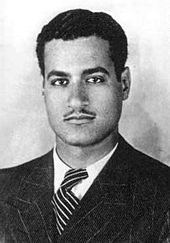
In 1937, Nasser applied to the Royal Military Academy for army officer training,[22] but his police record of anti-government protest participation initially blocked his entry.[23] Disappointed, he enrolled in the law school at King Fuad University,[23] but quit after one semester to reapply to the Military Academy.[24] Convinced that he needed a wasta, or an influential intermediary to promote his application above the others, Nasser managed to secure a meeting with Under-Secretary of War Ibrahim Khairy Pasha,[22] the person responsible for the academy's selection board, and requested his help.[23] Khairy Pasha agreed and sponsored Nasser's second application,[22] which was accepted in late 1937.[23][25] Nasser focused on his military career from then on, with little contact with his family. At the academy, he met Abdel Hakim Amer and Anwar Sadat, both of whom became important aides during his presidency.[22] After graduating from the academy in July 1938,[8] he was posted to the town of Mankabad near his native Beni Mur, and was commissioned as second lieutenant in the infantry.[26]
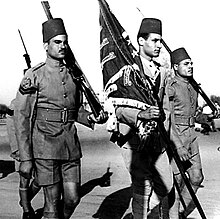
In 1941, Nasser and Amer were posted to Khartoum, Sudan, which was part of Egypt at the time.[26] After briefly returning from Sudan, Nasser returned in September 1942, then secured a job as an instructor in the Cairo Royal Military Academy in May 1943.[26]
In 1942 the British Ambassador Miles Lampson marched into King Farouk's palace and ordered him to dismiss Prime Minister Hussein Sirri Pasha for having pro-Axis sympathies. Nasser saw the incident as a blatant violation of Egyptian sovereignty and wrote, "I am ashamed that our army has not reacted against this attack",[27] and wished for "calamity" to overtake the British.[27] Nasser was accepted into the General Staff College later that year.[27] Nasser began to form a group of young military officers with strong nationalist sentiments who supported some form of revolution.[28] Nasser stayed in touch with the group's members primarily through Amer, who continued to discover interested officers within the Egyptian Armed Forces's various branches and presented Nasser with a full file on each of them.[29]
1948 Arab–Israeli War
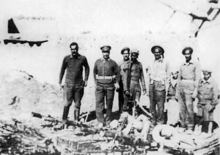
Nasser's first battlefield experience was in Palestine during the 1948 Arab–Israeli War.[30] He initially volunteered to serve with the Arab Higher Committee (AHC) led by Mohammad Amin al-Husayni. Nasser met with and impressed Al-Husayni,[31] but was ultimately refused entry to the AHC's forces by the Egyptian government[31] for unclear reasons.[32]
In May 1948, after the end of the British withdrawal, King Farouk sent the Egyptian army into Palestine,[33] with Nasser serving in the 6th Infantry Battalion.[34] During the war, he wrote of the Egyptian army's unpreparedness, saying "our soldiers were dashed against fortifications".[33] Nasser was deputy commander of the Egyptian forces that secured the Faluja pocket. On 12 July, he was lightly wounded in the fighting. By August, his brigade was surrounded by the Israeli Army. Their appeals for help from Jordan's Arab Legion went unheeded, and the brigade refused to surrender. Negotiations between Israel and Egypt finally resulted in the ceding of Faluja to Israel.[33] According to veteran journalist Eric Margolis, the Egyptian troops' endurance of heavy bombardment at Faluja while isolated from its command was "only one of two honorable Arab military actions during the 1947–49 Arab–Israeli war. Its defenders, including young army officer Gamal Abdel Nasser, became national heroes."[35]
The Egyptian singer Umm Kulthum hosted a public celebration for the officers' return despite reservations from the royal government, which had been pressured by the British government to prevent the reception. The apparent disconnect between the population and the palace during the officers' return increased Nasser's determination to topple the monarchy.[36] Nasser had also felt bitter that his brigade had not been relieved despite the resilience in which they performed.[37] He started writing his book Philosophy of the Revolution during the siege.[35]
After the war, he returned to his job as an instructor at the Royal Military Academy.[38] He sent emissaries to forge an alliance with the Muslim Brotherhood in October 1948, but concluded that the agenda of the Brotherhood was not compatible with his nationalism, and began a struggle to prevent the Brotherhood's influence over his activities.[33] Nasser was sent as a member of the Egyptian delegation to Rhodes in February 1949 to negotiate a formal armistice with Israel, and reportedly considered the terms to be humiliating, particularly because the Israelis were able to easily occupy the Eilat region whilst negotiating with the Arabs in March.[39]
Revolution
Free Officers
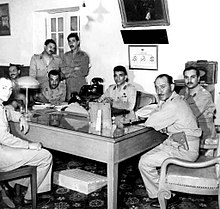
Nasser's return to Egypt coincided with Husni al-Za'im's Syrian coup d'état.[39] Its success and evident, popular support from the Syrian people further encouraged Nasser's revolutionary pursuits.[39] Soon after his return, he was summoned and interrogated by Prime Minister Ibrahim Abdel Hadi regarding suspicions that he was forming a secret group of dissenting officers.[39] According to secondhand reports, Nasser convincingly denied the allegations.[39] Abdel Hadi was also hesitant to take drastic measures against the army, especially in front of its chief of staff, who was present during the interrogation, and subsequently released Nasser.[39] The interrogation pushed Nasser to speed up his group's activities.[39] After 1949, the group adopted the name "Association of Free Officers" and advocated "little else but freedom and the restoration of their country’s dignity".[38] He organized the Free Officers' founding committee, which eventually comprised fourteen men from different social and political backgrounds, including representation from Young Egypt, the Muslim Brotherhood, the Egyptian Communist Party, and the aristocracy.[39] Nasser was unanimously elected chairman of the organization.[39]
In the 1950 parliamentary elections, the Wafd Party of el-Nahhas gained a victory—mostly due to the absence of the Muslim Brotherhood, who boycotted the elections—and was perceived as a threat by the Free Officers as they had campaigned on demands similar to their own.[40] Accusations of corruption against Wafd politicians began to surface, however, breeding an atmosphere of rumor and suspicion that consequently brought the Free Officers to the forefront of Egyptian politics.[41] By then, the organization had expanded to around ninety members; according to one member, Khaled Mohieddin, "nobody knew all of them and where they belonged in the hierarchy except Nasser".[41] Nasser felt that the Free Officers were not ready to move against the government, and for nearly two years, he did little beyond officer recruitment and underground news bulletins.[42]
On 11 October 1951, the Wafd government abrogated the 1936 Anglo-Egyptian Treaty, which had given the British control over the Suez Canal until 1956.[42] The popularity of this move, as well as that of government-sponsored guerrilla attacks against the British, put pressure on Nasser to act.[42] According to Sadat, Nasser decided to wage "a large scale assassination campaign".[43] In January 1952, he and a number of unidentified officers attempted to kill the royalist general Hussein Sirri Amer by firing their submachine guns at his car as he drove through the streets of Cairo.[43] Instead of killing the general, the attackers wounded an innocent female passerby.[43] Nasser recalled that her wails "haunted" him and firmly dissuaded him from undertaking similar actions in the future.[43]
Sirri Amer was close to King Farouk, and was nominated for the presidency of the Officer's Club—normally a ceremonial office—with his backing.[43] Nasser was determined to establish the independence of the army from the monarchy, and with Amer as the intercessor, resolved to field a nominee for the Free Officers.[43] They selected Muhammad Naguib, a popular general who had offered his resignation to Farouk in 1942 over British high-handedness and was wounded three times in the Palestine War.[44] Naguib won overwhelmingly and the Free Officers, through their connection with a leading Egyptian daily, al-Misri, publicized his victory while praising the nationalistic spirit of the army.[44]
Revolution of 1952
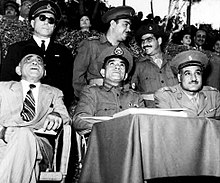
On 25 January 1952, British forces posted along the Suez Canal engaged in a major confrontation with the police force of Ismailia, resulting in the deaths of forty Egyptian policemen. The next day, riots in Cairo by Egyptian protesters ended in the deaths of 76 people, including nine British subjects. Afterward, Nasser published a simple six-point program for Egypt in Rose al-Yūsuf to dismantle feudalism and British influence. Then, in May 1952, Nasser received word that Farouk knew the names of the Free Officers and intended to arrest them; thus, he immediately entrusted Free Officer Zakaria Mohieddin with the task of drawing up plans for a takeover of the government by army units loyal to the association.[45]
The Free Officers' intention was not to install themselves in government, but to re-establish a parliamentary democracy. Nasser didn't believe that a low-ranking officer like himself (a lieutenant colonel) would be accepted by the Egyptian people, and so selected Naguib, a general, to be his "boss" and lead the coup in name. The revolution they had long sought was launched on 22 July and was declared a success the next day. The Free Officers seized control of all government buildings, radio stations, and police stations, as well as army headquarters in Cairo. While many of the rebel officers were leading their units, Nasser donned civilian clothing to avoid detection by royalists and moved around Cairo monitoring the situation.[45] In a move to stave off foreign intervention two days before the revolution, Nasser had notified the American and British governments of his intentions, and both had agreed not to aid Farouk.[45][46] Under pressure from the Americans, Nasser and his fellow revolutionaries had agreed to allow the deposed king to leave Egypt unharmed and with an honorary ceremony.[47]
Naguib assumed public authority as the leader of the new revolutionary government, becoming the first President of Egypt on 18 June 1953. On the same day, the monarchy was abolished and the Republic of Egypt declared.[45] According to Aburish, after assuming power, Nasser and the Free Officers expected to become the "guardians of the people's interests" against the monarchy and the pasha class while leaving the day-to-day tasks of government to civilians.[48] They asked Ali Maher, a former prime minister, to accept being reappointed to his previous position, and to form an all-civilian cabinet.[48] The Free Officers then governed as the Revolutionary Command Council (RCC) with Naguib as chairman and Nasser as vice-chairman.[49] Relations between the RCC and Maher grew tense, however, with the latter viewing many of Nasser's schemes—agrarian reform, abolition of the monarchy, reorganization of political parties[50]—as too radical, culminating in Maher's resignation on 7 September. Naguib assumed the additional role of prime minister, and Nasser that of deputy prime minister.[51][52] In September, the Agrarian Reform Law was put into effect.[50] In Nasser's eyes, this law gave the RCC its own identity and transformed the coup into a revolution.[53]
Preceding the reform law, in August 1952, communist-led riots broke out at textile factories in Kafr el-Dawwar, leading to a confrontation with the army that left nine people dead. Most of the RCC, including Naguib, insisted on making an example of the riot's two ringleaders by executing them, but Nasser firmly opposed this. Nonetheless, the sentences were carried out. The Muslim Brotherhood supported the RCC, and after Naguib's assumption of power, demanded four ministerial portfolios in the new cabinet. Nasser turned down their demands and instead hoped to co-opt the Brotherhood by giving two of their members, who were willing to serve officially as independents, minor ministerial posts.[53]
Road to presidency
Disputes with Naguib
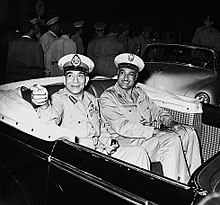
In January 1953, Nasser overcame opposition from Naguib and banned all political parties,[54] creating a one-party system under the Liberation Rally, a loosely-structured movement whose chief task was to organize pro-RCC rallies and lectures,[55] with Nasser its secretary-general.[56] Despite the dissolution order, Nasser was the only RCC member who still favored holding parliamentary elections, according to his fellow officer Abdel Latif Boghdadi.[54] Although outvoted, he still advocated holding elections by 1956.[54] In March 1953, Nasser led the Egyptian delegation negotiating a British withdrawal from the Suez Canal.[57]
When Naguib began showing signs of independence from Nasser by distancing himself from the RCC's land reform decrees and drawing closer to Egypt's established political forces, namely the Wafd and the Brotherhood,[58] Nasser resolved to depose him.[57] In June, Nasser took control of the interior ministry post from Naguib loyalist Sulayman Hafez,[58] and pressured Naguib to conclude the abolition of the monarchy.[57]
On 25 February 1954, Naguib announced his resignation after the RCC held an official meeting without his presence two days prior.[59] On 26 February, Nasser accepted the resignation, put Naguib under house arrest,[59] and the RCC proclaimed Nasser as both RCC chairman and prime minister.[60] As Naguib intended, a cavalry mutiny immediately followed, demanding Naguib's reinstatement and the RCC's dissolution.[59] While visiting the striking officers at Military Headquarters (GHQ) to call for the mutiny's end, Nasser was initially intimidated into accepting their demands.[61] However, on 27 February, Nasser's supporters in the army launched a raid on the GHQ, ending the mutiny.[62] Later that day, hundreds of thousands of protesters, mainly belonging to the Brotherhood, called for Naguib's return and Nasser's imprisonment.[63] In response, a sizable group within the RCC, led by Khaled Mohieddin, demanded Naguib's release and return to the presidency.[57] Nasser was forced to acquiesce, but delayed Naguib's reinstatement until 4 March, allowing him to promote Amer to Commander of the Armed Forces—a position formerly occupied by Naguib.[64]
On 5 March, Nasser's security coterie arrested thousands of participants in the uprising.[63] As a ploy to rally opposition against a return to the pre-1952 order, the RCC decreed an end to restrictions on monarchy-era parties and the Free Officers' withdrawal from politics.[63] The RCC succeeded in provoking the beneficiaries of the revolution, namely the workers, peasants, and petty bourgeois, to oppose the decrees,[65] with one million transport workers launching a strike and thousands of peasants entering Cairo in protest in late March.[66] Naguib sought to crackdown on the protesters, but his requests were rebuffed by the heads of the security forces.[67] On 29 March, Nasser announced the decrees' revocation in response to the "impulse of the street."[67] Between April and June, hundreds of Naguib's supporters in the military were either arrested or dismissed, and Mohieddin was informally exiled to Switzerland to represent the RCC abroad.[67] King Saud of Saudi Arabia attempted to mend relations between Nasser and Naguib, but to no avail.[68]
Assuming chairmanship of RCC
On 26 October 1954, Muslim Brotherhood member Mohammed Abdel Latif attempted to assassinate Nasser while he was delivering a speech in Alexandria to celebrate the British military withdrawal. The speech was broadcast to the Arab world via radio. The gunman was 25 feet (7.6 m) away from him and fired eight shots, but all missed Nasser. Panic broke out in the mass audience, but Nasser maintained his posture and raised his voice to appeal for calm.[69][70] With great emotion he exclaimed the following:
My countrymen, my blood spills for you and for Egypt. I will live for your sake and die for the sake of your freedom and honor. Let them kill me; it does not concern me so long as I have instilled pride, honor, and freedom in you. If Gamal Abdel Nasser should die, each of you shall be Gamal Abdel Nasser ... Gamal Abdel Nasser is of you and from you and he is willing to sacrifice his life for the nation.[70]
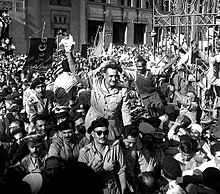
The crowd roared in approval and Arab audiences were electrified. The assassination attempt backfired, quickly playing into Nasser's hands.[71] Upon returning to Cairo, he ordered one of the largest political crackdowns in the modern history of Egypt,[71] with the arrests of thousands of dissenters, mostly members of the Brotherhood, but also communists, and the dismissal of 140 officers loyal to Naguib.[71] Eight Brotherhood leaders were sentenced to death,[71] although the sentence of its chief ideologue, Sayyed Qutb, was commuted to a 15-year imprisonment.[72] President Naguib was removed from the presidency and put under house arrest, but was never tried or sentenced, and no one in the army rose to defend him. With his rivals neutralized, Nasser became the undisputed leader of Egypt.[70]
Nasser's street following was still too small to sustain his plans for reform and to secure him in office.[73] To promote himself and the Liberation Rally, he gave speeches in a cross-country tour,[73] and imposed controls over the country's press by decreeing that all publications had to be approved by the party to prevent "sedition".[74] Both Umm Kulthum and Abdel Halim Hafez, the leading Arab singers of the era, made songs praising Nasser's nationalism. Others produced plays denigrating his political opponents.[73] According to his associates, Nasser orchestrated the campaign himself.[73] Arab nationalist terms such "Arab homeland" and "Arab nation" frequently began appearing in his speeches in 1954–55, whereas prior he would refer to the Arab "peoples" or the "Arab region".[75] In January 1955, the RCC appointed him as their president, pending national elections.[73]
Nasser made secret contacts with Israel in 1954–55, but determined that peace with Israel would be impossible, considering it an "expansionist state that viewed the Arabs with disdain".[76] On 28 February 1955, Israeli troops attacked the Egyptian-held Gaza Strip with the stated aim of suppressing Palestinian fedayeen raids. Nasser did not feel that the Egyptian Army was ready for a confrontation and did not retaliate militarily. His failure to respond to Israeli military action demonstrated the ineffectiveness of his armed forces and constituted a blow to his growing popularity.[77][78] Nasser subsequently ordered the tightening of the blockade on Israeli shipping through the Straits of Tiran and restricted the use of airspace over the Gulf of Aqaba by Israeli aircraft in early September.[77] The Israelis re-militarized the al-Auja Demilitarized Zone on the Egyptian border on 21 September.[78]
Simultaneous with Israel's February raid, the Baghdad Pact was formed between some regional allies of the UK, including Iraq. Nasser considered the Baghdad Pact a threat to Egyptian efforts in destroying British military influence in the Middle East, and a mechanism to undermine the Arab League and "perpetuate [Arab] subservience to Zionism and [Western] imperialism".[77] Nasser felt that if he was to maintain Egypt's regional leadership position he needed to acquire modern weaponry to arm his military. When it became apparent to him that Western countries would not supply Egypt under acceptable financial and military terms,[77][78][79] Nasser turned to the Eastern Bloc and concluded a US$320,000,000 armaments agreement with Czechoslovakia on 27 September.[77][78] Through the Czechoslovakian arms deal, the balance of power between Egypt and Israel was more or less equalized and Nasser's role as the Arab leader defying the West was enhanced.[78]
Adoption of neutralism
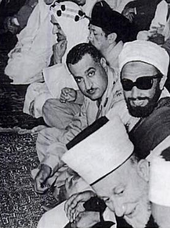
At the Bandung Conference in Indonesia in late April, Nasser was treated as the leading representative of the Arab countries and was one of the most popular figures at the summit.[80][81] He had paid earlier visits to Pakistan (April 9),[82] India (April 14),[83] Burma, and Afghanistan on the way to Bandung,[84] and previously cemented a treaty of friendship with India in Cairo on 6 April, strengthening Egyptian–Indian relations on the international policy and economic development fronts.[85]
Nasser mediated discussions between the pro-Western, pro-Soviet, and neutralist conference factions over the composition of the "Final Communique"[80] addressing colonialism in Africa and Asia and the fostering of global peace amid the Cold War between the West and the Soviet Union. Nasser's Bandung efforts devotedly sought a proclamation for the avoidance of international defense alliances, support for the independence of Tunisia, Algeria, and Morocco from French rule, support for the Palestinian right of return, and the implementation of UN resolutions regarding the Arab–Israeli conflict. He succeeded in lobbying the attendees to pass resolutions on each of these issues, notably securing the strong support of China and India.[86]
Following Bandung, Nasser officially adopted the "positive neutralism" of Yugoslavian president Josip Broz Tito and Indian president Jawaharlal Nehru as a principal theme of Egyptian foreign policy regarding the Cold War.[81][87] Nasser was welcomed by large crowds of people lining the streets of Cairo on his return to Egypt on 2 May and was widely heralded in the press for his achievements and leadership in the conference. Consequently, Nasser's prestige was greatly boosted as was his self-confidence.[88]
1956 constitution and presidency
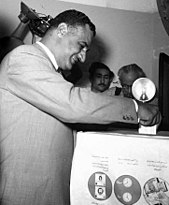
With his domestic position considerably strengthened, Nasser was able to secure primacy over his RCC colleagues and gained relatively unchallenged decision-making authority,[84] particularly over foreign policy.[89]
In January 1956, the new Constitution of Egypt was drafted, entailing the establishment of a single-party system under the National Union (NU),[89] a movement Nasser described as the "cadre through which we will realize our revolution".[90] The NU was a reconfiguration of the Liberation Rally,[91] which Nasser determined had failed in generating mass public participation.[92] In the new movement, Nasser attempted to incorporate more citizens, approved by local-level party committees, in order to solidify popular backing for his government.[92] The NU would select a nominee for the presidential election whose name would be provided for public approval.[89]
Nasser's nomination for the post and the new constitution were put to public referendum on 23 June and each was approved by an overwhelming majority.[89] A 350-member National Assembly was established,[91] elections for which were held in July 1957. Nasser had ultimate approval over all the candidates.[93] The constitution granted women's suffrage, prohibited gender-based discrimination, and entailed special protection for women in the workplace.[94] Coinciding with the new constitution and Nasser's presidency, the RCC dissolved itself and its members resigned their military commissions as part of the transition to civilian rule.[95] During the deliberations surrounding the establishment of a new government, Nasser began a process of sidelining his rivals among the original Free Officers, while elevating his closest allies to high-ranking positions in the cabinet.[89]
Nationalization of Suez Canal
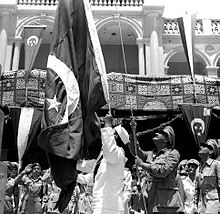
After the three-year transition period ended with Nasser's official assumption of power, his domestic and independent foreign policies increasingly collided with the regional interests of the UK and France. The latter condemned his strong support for Algerian independence from France, and the UK's Eden government was agitated by Nasser's campaign against the Baghdad Pact, which Nasser viewed as a disruption of "Arab solidarity".[95] In addition, Nasser's adherence to neutralism regarding the Cold War, recognition of the Communist People's Republic of China, and the arms deal with Eastern bloc alienated the United States. On 19 July 1956, the US and UK abruptly withdrew their offer to finance construction of the Aswan Dam,[95] citing concerns that Egypt's economy would be overwhelmed by the project.[96]
Nasser was informed of the British–American withdrawal via a news statement while aboard a plane returning to Cairo from Belgrade, and took great offense.[97] Although ideas for nationalizing the Suez Canal were in the offing after the UK agreed to withdraw its military from Egypt in 1954 (the last British troops left on 13 June 1956), journalist Mohamed Hassanein Heikal asserts that Nasser made the final decision to nationalize the waterway between 19 July and 20 July.[97] Nasser himself would later state he decided on 23 July, after studying the issue and holding deliberations with a number of his advisers from the dissolved RCC, namely Boghdadi and technical specialist Mahmoud Younis beginning on 21 July.[97] The rest of the RCC's former members were informed of the decision on 24 July, while the bulk of the cabinet was unaware of the nationalization scheme until hours before Nasser publicly announced it.[97]
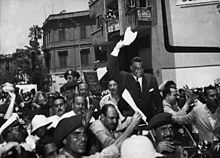
On 26 July 1956, Nasser gave a speech in Alexandria announcing the nationalization of the Suez Canal Company as a means to fund the Aswan Dam project in light of the British–American withdrawal.[98] In the speech, he denounced British imperialism in Egypt and their control over the canal company's profits, and upheld that the Egyptian people had a right to sovereignty over the waterway, especially since 120,000 Egyptians had died building it.[98] The motion was technically in breach of the agreement he had signed with the UK on 19 October 1954,[99] although he ensured that all existing stockholders would be paid off.[100]
The nationalization announcement was greeted by the audience very emotionally, and throughout the Arab world, thousands entered the streets shouting slogans of support.[101] US ambassador Henry A. Byroade stated, "I cannot overemphasize [the] popularity of the Canal Company nationalization within Egypt, even among Nasser's enemies."[99] Egyptian political scientist Mahmoud Hamad wrote that prior to 1956, Nasser had consolidated control over Egypt's military and civilian bureaucracies, but it was only after the canal's nationalization that he gained near-total popular legitimacy and firmly established himself as the "charismatic leader" and "spokesman for the masses not only in Egypt, but all over the Third World".[102] According to Aburish, this was Nasser's largest pan-Arab triumph at the time and "soon his pictures were to be found in the tents of Yemen, the souks of Marrakesh, and the posh villas of Syria".[101] The official reason given for the nationalization was that funds from the Suez Canal would be used for the construction of the dam in Aswan.[99] That same day, Egypt closed the canal to Israeli shipping.[100]
Suez Crisis
France and the UK, the largest shareholders in the Suez Canal Company, saw its nationalization as yet another hostile measure aimed at them by the Egyptian government. Nasser was aware that the canal's nationalization would instigate an international crisis and believed the prospect of intervention by the two countries was 80% likely.[103] He believed, however, that the UK would not be able to intervene militarily for at least two months after the announcement, and dismissed Israeli action as "impossible".[104] In early October, the UN Security Council met on the matter of the canal's nationalization and adopted a resolution recognizing Egypt's right to control the canal as long as it continued to allow passage through it for foreign ships.[105] According to Heikal, after this agreement, "Nasser estimated that the danger of invasion had dropped to 10 percent."[106] Shortly thereafter, however, the UK, France, and Israel colluded in a secret agreement to take over the Suez Canal, occupy parts of Egypt,[99][107] and topple Nasser.[108][109][110]
On 29 October 1956, Israeli forces crossed the Sinai, overwhelmed Egyptian army posts, and quickly advanced through the peninsula to achieve their objectives. Two days later, British and French planes bombarded Egyptian airfields in the canal zone.[111] Nasser ordered the military's high command to withdraw the Egyptian Army from Sinai to bolster the canal's defenses.[112] Moreover, he feared that if the armored corps was dispatched to confront the Israeli invading force and the British and French subsequently landed in the canal city of Port Said, Egyptian armor in the Sinai would end up cut off from the canal and destroyed by the combined tripartite forces.[112] Amer strongly disagreed, insisting that Egyptian tanks meet the Israelis in battle,[112] The two engaged in a heated exchanged on 3 November, but Amer conceded.[112] Nasser also ordered blockage of the canal by sinking or otherwise disabling forty-nine ships at its entrance.[111]
Despite the commanded withdrawal of Egyptian troops, about 2,000 Egyptian soldiers were killed during engagement with Israeli forces and retreat,[113] and some 5,000 Egyptian soldiers were captured by the Israeli Army.[112] Amer and Salah Salem proposed requesting a ceasefire, with Salem further recommending that Nasser surrender himself to British forces.[99] Nasser berated Amer and Salem, and vowed, "Nobody is going to surrender."[111] Nasser assumed military command. Despite the relative ease in which Sinai was occupied, Nasser's prestige at home and among Arabs was undamaged.[114] To counterbalance the Egyptian Army's dismal performance, Nasser authorized the distribution of about 400,000 rifles to civilian volunteers and hundreds of militias were formed throughout Egypt, many led by Nasser's political opponents.[115]
It was at Port Said that Nasser saw a confrontation with the invading forces as being the strategic and psychological focal point of Egypt's defense.[116] A third infantry battalion and hundreds of national guardsmen were sent to the city as reinforcements, while two regular companies were dispatched to organize popular resistance.[116] Nasser and Boghdadi traveled to the canal zone to boost the morale of the armed volunteers. According to Boghdadi's memoirs, Nasser described the Egyptian Army as "shattered" as he saw the wreckage of Egyptian military equipment en route.[116] When British and French forces landed in Port Said on 5–6 November, its local militia put up a stiff resistance, resulting in street-to-street fighting.[115][117] The Egyptian Army commander in the city was preparing to request terms for a ceasefire, but Nasser ordered him to desist. The British-French forces managed to largely secure the city by 7 November.[117] Between 750 and 1,000 Egyptians were killed in the battle for Port Said.[113]
The US Eisenhower administration condemned the tripartite invasion, and supported UN resolutions demanding withdrawal and a United Nations Emergency Force (UNEF) to be stationed in Sinai.[118] Nasser commended Eisenhower, stating he played the "greatest and most decisive role" in stopping the "tripartite conspiracy".[119] By the end of December, British and French forces had totally withdrawn from Egyptian territory,[118] while Israel completed its withdrawal in March 1957 and released all Egyptian prisoners of war.[113][120] As a result of the Suez Crisis, Nasser brought in a set of regulations imposing rigorous requirements for residency and citizenship, mostly affecting Jews—both Egyptian and foreign—and British and French nationals, thousands of whom were expelled or compelled to leave the country.[121]
On 8 April, the canal was reopened,[122] and Nasser's political position was enormously enhanced by the widely perceived failure of the invasion and attempt to topple him. Nutting claimed the crisis "established Nasser finally and completely" as the rayyes (president) of Egypt.[99]
Pan-Arabism and socialism
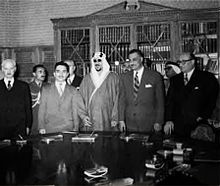
By 1957, pan-Arabism was the dominant ideology of the Arab world, and the average Arab citizen considered Nasser its undisputed leader.[123] Historian Adeed Dawisha credited Nasser's status to his "charisma, bolstered by his perceived victory in the Suez Crisis".[123] The Cairo-based Voice of the Arabs radio station spread Nasser's ideas of united Arab action throughout the Arabic-speaking world and historian Eugene Rogan wrote, "Nasser conquered the Arab world by radio."[124] Lebanese sympathizers of Nasser and the Egyptian embassy in Beirut—the press center of the Arab world—bought out Lebanese media outlets to further disseminate Nasser's ideals.[125] Nasser also enjoyed the support of Arab nationalist organizations, both civilian and paramilitary, throughout the region. His followers were numerous and well-funded, but lacked any permanent structure and organization. They called themselves "Nasserites", despite Nasser's objection to the label (he preferred the term "Arab nationalists").[125]
In January 1957, the US adopted the Eisenhower Doctrine and pledged to prevent the spread of communism and its "agents" in the Middle East.[126] Although Nasser was an opponent of communism in the region, his promotion of pan-Arabism was viewed as a threat by regional pro-Western states.[126][127] Eisenhower attempted to isolate Nasser and reduce his regional influence by attempting to transform King Saud as a counterweight.[126][127] Also in January, the elected Jordanian prime minister and Nasser supporter[128] Sulayman al-Nabulsi brought Jordan into a military pact with Egypt, Syria, and Saudi Arabia.[129]
Relations between Nasser and King Hussein deteriorated in April when Hussein implicated Nasser in two coup attempts against him[129][130]—although Nasser's involvement was never established[131][132]—and dissolved al-Nabulsi's cabinet.[129][130] Nasser subsequently slammed Hussein on Cairo radio as being "a tool of the imperialists".[133] Relations with King Saud also became antagonistic as the latter began to fear that Nasser's increasing popularity in Saudi Arabia was a genuine threat to the royal family's survival.[129] Despite opposition from the governments of Jordan, Saudi Arabia, Iraq, and Lebanon, Nasser maintained his prestige among their citizens and those of other Arab countries.[125]
By the end of 1957, Nasser nationalized all remaining British and French assets in Egypt, including the tobacco, cement, pharmaceutical, and phosphate industries.[134] When efforts to offer tax incentives and attract outside investments yielded no tangible results, he nationalized more companies and made them a part of his economic development organization.[134] He stopped short of total government control: two-thirds of the economy was still in private hands.[134] Yet, this effort did achieve a measure of success, with increased agricultural production and investment in industrialization.[134] Nasser initiated the Helwan steelworks, which were on their way to becoming Egypt's largest enterprise, providing the country with product and tens of thousands of jobs.[134] Nasser also decided to cooperate with the USSR in the construction of the Aswan Dam to replace the withdrawal of US funds.[134]
United Arab Republic

Despite his popularity with the people of the Arab world, by mid-1957 his only regional ally was Syria.[135] In September, Turkish troops massed along their Syrian border amid rumors that the Baghdad Pact countries were attempting to topple Syria's leftist government.[135] Nasser sent a contingent force to Syria as a symbolic display of solidarity, further elevating his prestige in the Arab world, and particularly among Syrians.[135]
As political instability grew considerably in Syria, delegations from the country were sent to Nasser demanding immediate unification with Egypt.[136] Nasser initially turned down the request, citing the two countries' incompatible political and economic systems, lack of contiguity, the Syrian military record of intervention in politics, and the deep factionalism among Syria's political forces.[136] However, in January 1958, a second Syrian delegation managed to convince Nasser of an impending communist takeover and a consequent slide to civil strife.[137] Nasser subsequently opted for union, albeit on the condition that it would be a total political merger with him as its president, to which the delegates and Syrian president Shukri al-Quwatli agreed.[138] On 1 February, the United Arab Republic (UAR) was proclaimed and, according to Dawisha, the Arab world reacted in "stunned amazement, which quickly turned into uncontrolled euphoria."[139] Nasser ordered a crackdown against Syrian communists, dismissing many of them from their governmental posts.[140][141]

On 24 February, Nasser traveled to Damascus in a surprise visit to celebrate the union.[142] He was welcomed by crowds that swelled to the hundreds of thousands.[142] Crown Prince Imam Badr of North Yemen was dispatched to Damascus with proposals to include his country in the new republic. Nasser agreed to establish a loose federal union with Yemen in place of total integration: the United Arab States.[143] While Nasser was in Syria, King Saud planned to have him assassinated on his return flight to Cairo.[144] On 4 March, Nasser addressed the masses in Damascus and waved before them the Saudi check given to Syrian security chief and Nasser supporter Abdel Hamid Sarraj to shoot down Nasser's plane.[145] As a consequence of Saud's scheme, he was forced by senior members of the Saudi royal family to informally cede most of his powers to his brother, King Faisal, a major opponent of Nasser and advocate for pan-Islamic unity over pan-Arabism.[146]
A day after announcing the attempt on his life, Nasser established a new provisional constitution proclaiming a 600-member National Assembly (400 from Egypt and 200 from Syria) and the disbanding of all political parties, including the Ba'ath.[146] Nasser gave each of the provinces two vice-presidents: Boghdadi and Amer in Egypt, and Sabri al-Asali and Akram al-Hawrani in Syria.[146] Nasser then left for Moscow to meet with Nikita Khrushchev. At the meeting, Khrushchev pressed Nasser to lift the ban on the Communist Party, but Nasser refused, stating it was an internal matter which was not a subject of discussion with outside powers. Khrushchev was reportedly taken aback and denied he had meant to interfere in the UAR's affairs. Both leaders did not want a rift between their two countries, and thus the issue was settled.[147]
Influence on the Arab world
The holy march on which the Arab nation insists, will carry us forward from one victory to another ... the flag of freedom which flies over Baghdad today will fly over Amman and Riyadh. Yes, the flag of freedom which flies over Cairo, Damascus, and Baghdad today will fly over the rest of the Middle East ...
Gamal Abdel Nasser, 19 July in Damascus[148]
In Lebanon, clashes between pro-Nasser factions and supporters of staunch Nasser opponent, then-President Camille Chamoun, culminated in civil strife by May.[149] The former sought to unite with the UAR, while the latter sought Lebanon's continued independence.[149] Nasser delegated oversight of the issue to Sarraj, who provided limited aid to Nasser's Lebanese supporters through money, light arms, and officer training[150]—short of the large-scale support that Chamoun alleged.[151] Nasser did not intend to covet Lebanon, seeing it as a "special case", but sought to prevent Chamoun from a second presidential term.[152]
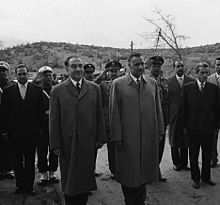
On 14 July, Iraqi army officers Abdel Karim Qasim and Abdel Salam Aref overthrew the Iraqi monarchy, and the next day, Iraqi prime minister and Nasser's chief Arab antagonist, Nuri al-Said, was killed.[153] Nasser recognized the new government and stated that "any attack on Iraq was tantamount to an attack on the UAR".[154] On 15 July, US marines landed in Lebanon, and British special forces in Jordan, upon the request of those countries' governments to prevent them from falling to pro-Nasser forces. Nasser felt that the revolution in Iraq left the road for pan-Arab unity unblocked.[154] On 19 July, for the first time, Nasser declared that he was opting for full Arab union, although he had no plan to merge Iraq with the UAR.[148] Although most members of the Iraqi Revolutionary Command Council (RCC) favored Iraqi-UAR unity,[155] Qasim sought to keep Iraq independent and resented Nasser's large popular base in the country.[153]
In the fall of 1958, Nasser formed a tripartite committee consisting of Zakaria Mohieddin, al-Hawrani, and Salah Bitar to oversee developments in Syria.[156] By moving the latter two, who were Ba'athists, to Cairo, he neutralized important political figures who had their own ideas about how Syria should be run.[156] He put Syria under Sarraj, who effectively reduced the province into a police state by imprisoning and exiling landholders who objected to the introduction of Egyptian agricultural reform in Syria, and communists.[156] Following the Lebanese election of Fuad Chehab in September 1958, relations between Lebanon and the UAR improved considerably.[157] On 25 March 1959, Chehab and Nasser met at the Lebanese–Syrian border and compromised for an end to the Lebanese crisis.[157]
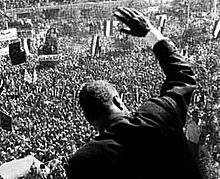
Relations between Nasser and Qasim grew increasingly bitter on 9 March,[158] after Qasim's forces suppressed a rebellion in Mosul, launched a day earlier by a pro-Nasser Iraqi RCC officer backed by UAR authorities.[159] Nasser had considered dispatching troop to aid his Iraqi sympathizers, but decided against it.[160] Nasser clamped down on Egyptian communist activity due to the key backing Iraqi communists provided Qasim. Several influential communists were arrested, including Nasser's old comrade Khaled Mohieddin, who had been allowed re-entry into Egypt in 1956.[158]
By December, the political situation in Syria was faltering and Nasser responded by appointing Amer as governor-general alongside Sarraj. Syria's leaders reacted with opposition to the appointment and many resigned from their government posts. Nasser later met with the opposition leaders and in a heated moment, exclaimed that he was the "elected" president of the UAR and those who did not accept his authority could "walk away".[156]
Collapse of the union and aftermath
Opposition to the union mounted among some of Syria's key elements,[161] namely the socioeconomic, political, and military elites.[162] In response to Syria's worsening economy, which Nasser attributed to its control by bourgeoisie classes, in July 1961, Nasser decreed socialist measures that nationalized wide-ranging sectors of the Syrian economy.[163] He also dismissed Sarraj in September to curb the growing political crisis. Aburish states that Nasser was not fully capable of addressing Syrian problems because they were "foreign to him".[164] In Egypt, the economic situation was more positive, with a GNP growth of 4.5 percent and a rapid growth of industry.[164] In 1960, Nasser nationalized the Egyptian press, which had already been cooperative with his government, in order to steer coverage towards the country's socioeconomic issues and galvanize public support for his socialist efforts.[74]
On 28 September 1961, secessionist army units launched a coup in Damascus, declaring Syria's secession from the UAR.[165] In response, pro-union army units in northern Syria revolted and pro-Nasser protests occurred in major Syrian cities.[162] Nasser sent Egyptian special forces to Latakia to bolster his allies, but withdrew them two days later, citing his refusal to allow inter-Arab fighting.[166] Addressing the UAR's breakup on 5 October,[167] Nasser accepted personal responsibility[166] and declared that Egypt would recognize an elected Syrian government.[167] He privately blamed interference by hostile Arab governments.[166] According to Heikal, Nasser suffered something resembling a nervous breakdown and his health began to deteriorate after the dissolution of the union.[166] He also began to smoke more heavily.[166]
In October 1961, Nasser embarked on a major nationalization program for Egypt, believing the total adoption of socialism was the answer to his country's problems and would have prevented Syria's secession. The Charter for National Action was undertaken, creating youth groups, socialist study institutes, and agricultural cooperatives. In the process, the National Union was renamed the Arab Socialist Union (ASU).[168] By 1962, as a result of these measures, government ownership of Egyptian business reached 51 percent.[169] With the measures also came more domestic repression, with thousands of Islamists imprisoned, including dozens of military officers.[168] Nasser's tilt toward a Soviet-style system led his aides Abdel Latif Boghdadi and Hussein el-Shafei to submit their resignations in protest.[170]
Revival on regional stage
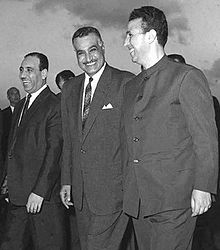
Nasser's regional position changed unexpectedly when Yemeni officers led by Nasser supporter Abdullah al-Sallal overthrew Imam Badr of North Yemen on 27 September 1962.[170] Al-Badr and his tribal partisans began receiving increasing support from Saudi Arabia to help reinstate the kingdom, while Nasser subsequently accepted a request by Sallal to militarily aid the new government on 30 September.[171] Consequently, Egypt became embroiled in the in the long-drawn civil war until it withdrew its forces in 1967.[171] Most of Nasser's old colleagues had questioned the wisdom of continuing the war, but Amer would reassure Nasser of their coming victory.[172] Nasser later remarked in 1968 that intervention in Yemen was a "miscalculation".[171]
In July 1962, Algeria became independent of France.[172] As a staunch political and financial supporter of the Algerian independence movement, Nasser considered the country's independence to be a personal victory.[172] Amid these developments, a pro-Nasser clique in the Saudi royal family led by Prince Talal defected to Egypt, along with the Jordanian chief of staff, in early 1963.[173]
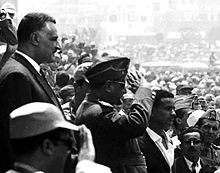
On 8 February 1963, a military coup in Iraq led by a Ba'athist–Nasserist alliance toppled Qasim, who was subsequently shot dead. Abdel Salam Aref, a Nasserist, was chosen to be the new president.[172] A similar alliance toppled the Syrian government on 8 March.[174] The new Iraqi and Syrian governments soon sent Nasser delegations to push for a new Arab union on 14 March.[175] At the meeting, Nasser lambasted the Ba'athists for "facilitating" Syria's split from the UAR[176] and asserted that he was the "leader of the Arabs".[175] A transitional unity agreement stipulating a federal system[175] was signed by the parties on 17 April and the new union was set to be established in May 1965.[177] However, the agreement fell apart weeks later when Syria's Ba'athists purged Nasser's supporters from the officers corps. A failed counter-coup by a Nasserist colonel followed, after which Nasser condemned the Ba'athists as "fascists".[178]
In January 1964, Nasser called for an Arab League summit in Cairo to establish a unified Arab response against Israel's plans to divert the Jordan River's waters for economic purposes, which Syria and Jordan deemed an act of war.[179] Nasser blamed Arab divisions for what he deemed "the disastrous situation".[180] He discouraged Syria and Palestinian guerrillas from provoking the Israelis, conceding that he had no plans for war with Israel.[180] During the summit, Nasser developed cordial relations with King Hussein, and ties were mended with the rulers of Saudi Arabia, Syria, and Morocco.[179] In May, Nasser moved to formally share his leadership position over the Palestine issue[180] by initiating the creation of the Palestine Liberation Organization (PLO).[180][181] In practice, Nasser used the PLO to wield control over the Palestinian fedayeen.[181] Its head was to be Ahmad Shukeiri, Nasser's personal nominee.[180]
After years of foreign policy coordination and developing ties, Nasser, Yugoslavian President Tito, and Indian President Nehru founded the Non-Aligned Movement (NAM) in 1961.[182] Its declared purpose was to solidify international non-alignment and promote world peace amid the Cold War, end colonization, and increase economic cooperation among developing countries.[183] In 1964, Nasser was made president of the NAM and held the second conference of the organization in Cairo.[184] He also received the Hero of the Soviet Union award that year.[185]
Nasser served as one of the key figures in the strengthening of African solidarity in the late 1950s and early 1960s, although his continental leadership role had increasingly passed to Algeria since 1962.[186] During this period, Nasser made Egypt a refuge for anti-colonial leaders from several African countries and allowed broadcast of anti-colonial propaganda from Cairo.[186] Beginning in 1958, Nasser played an instrumental role in the discussions among African leaders that led to the establishment of the Organisation of African Unity (OAU) in 1963.[186]
Modernization efforts and internal dissent

Al-Azhar
In 1961, Nasser sought to firmly establish Egypt as the leader of the Arab world and to promote a second revolution in Egypt with the purpose of merging Islamic and socialist thinking to satisfy the will of the general populace.[187] To achieve this, he initiated several reforms to modernize the al-Azhar, which serves as the de facto leading authority in Sunni Islam, and to ensure its prominence over the Muslim Brotherhood and the more conservative Wahhabism promoted by Saudi Arabia.[187] Nasser had used al-Azhar's most willing ulema (scholars) as a counterweight to the Brotherhood's Islamic influence, starting in 1953.[54]
Nasser guided al-Azhar to create changes in its syllabus that trickled to the lower levels of Egyptian education, consequently allowing the establishment of coeducational schools and the introduction of evolution into school curriculum. The reforms also included the merger of religious and civil courts.[187] Moreover, Nasser forced al-Azhar to issue a fatwā admitting Shia Muslims, Alawites, and Druze into mainstream Islam; for centuries prior, al-Azhar deemed them to be "heretics".[187]
Rivalry with Amer
Following Syria's secession, Nasser grew concerned with Amer's inability to train and modernize the army, and with the state within a state Amer had created in the military command and intelligence apparatus.[188][189] In late 1961, Nasser established the Presidential Council and decreed it the authority to approve all senior military appointments instead of leaving this responsibility solely to Amer.[190][191] Moreover, he instructed that the primary criterion for promotion to be merit and not personal loyalties.[190] Nasser retracted the initiative after Amer's allies in the officers corps threatened to mobilize against him.[191]
In early 1962 Nasser again attempted to wrest control of the military command from Amer.[191] Amer responded by directly confronting Nasser for the first time and secretly rallying his loyalist officers.[190][192] Nasser ultimately backed down, wary of possible violent confrontation between the military and his civilian government.[193] According to Boghdadi, the stress caused by the UAR's collapse and Amer's increasing autonomy forced Nasser, who had already had diabetes, to practically live on painkillers from then on.[194]
New constitution and second term
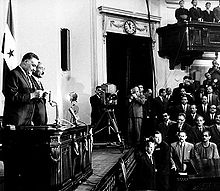
In order to organize and solidify his popular base with Egypt's citizens and counter the army's influence, Nasser introduced the National Charter in 1962 and a new constitution.[188] The former called for universal health care, affordable housing, vocational schools, Suez Canal widening, greater women's rights, and a family planning program.[188] In addition, he attempted to maintain oversight of the country's civil service to prevent it from inflating and consequently becoming a burden to the state.[188] New laws provided workers with a minimum wage, profit shares, free education, free health care, reduced working hours, and encouragement to participate in management. Land reforms guaranteed the security of tenant farmers,[195] promoted agricultural growth, and reduced rural poverty.[196]
During the presidential referendum in Egypt, Nasser was re-elected to a second term as UAR president and took his oath on 25 March 1965. He was the only candidate for the position, with virtually all of his political opponents forbidden from running for office by law and his fellow party members reduced to mere followers. That same year, Nasser had the Muslim Brotherhood chief ideologue Sayyed Qutb imprisoned.[197] Qutb was charged and found guilty by the court of plotting to assassinate Nasser and was executed in 1966.[197]
Beginning in 1966, as Egypt's economy slowed and government debt became an increasing burden on the state, Nasser began to ease state control over the private sector, encouraging state-owned bank loans to private business and introducing incentives to increase exports.[198] Sometime during this year, Nasser suffered and survived a heart attack.[199]
Six-Day War
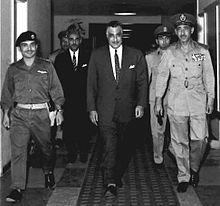
In early 1967, the USSR warned Nasser of an impending Israeli attack on Syria.[200][201] Amer used the warnings as a pretext to dispatch troops to Sinai and demand the UNEF withdrawal without authorization from Nasser on 14 May.[201][202] That day, Nasser received a warning by King Hussein on 2 May that Hussein's sources in Washington had informed him of Israeli-American collusion to drag Egypt into war.[203] The message had been originally received by Amer on 2 May, but Nasser only gained knowledge on 14 May, following the Sinai deployment.[203][204] Although in the preceding months, Hussein and Nasser had been accusing each other of insincerity in the fight with Israel,[205] Hussein was wary that an Egyptian-Israeli war would risk the West Bank's occupation by Israel.[203] On 15 May, Nasser attempted to de-escalate by requesting the UNEF to limit its withdrawal to north Sinai, but the UN refused.[203] Despite the warnings, Nasser still felt that the US would restrain Israel from attacking due to assurances from the US and the USSR.[206] In turn, he also reassured both countries that Egypt would only act defensively.[206]
On 21 May, without Nasser's authorization, Amer ordered the Straits of Tiran blockaded, a move Nasser believed Israel would use as a casus belli.[203] Amer reassured him that the army was prepared for confrontation,[207][208] but Nasser doubted Amer's assessment of the military's readiness.[207] Moreover, Amer anticipated an impending Israeli attack and advocated a preemptive strike.[209][210] Nasser refused the call[210][211] upon determination that the the air force lacked pilots and Amer's handpicked officers lacked competence.[211] Nonetheless, Nasser concluded that if Israel attacked, Egypt's quantitative advantage in manpower and arms could stave off Israeli forces for at least two weeks, allowing for diplomacy towards a ceasefire.[212] Towards the end of May, Nasser increasingly exchanged his positions of deterrence for deference to its inevitability,[212][213] under increased pressure to act by both the general Arab populace and various Arab governments.[200][214] On 30 May, King Hussein committed Jordan alongside Egypt and Syria in the United Arab Command alliance.[215]
On the morning of 5 June, the Israeli Air Force struck Egyptian air fields, destroying much of the Egyptian Air Force. Before the day ended, Israeli armored units had cut through Egyptian defense lines and captured the town of el-Arish.[216] The next day, Amer ordered the immediate withdrawal of Egyptian troops from Sinai—the majority of Egyptian casualties during the war.[217] According to Sadat, it was only when the Israelis cut off the Egyptian garrison at Sharm el-Sheikh that Nasser became aware of the situation's gravity.[216] After hearing of the attack, he rushed to army headquarters to inquire about the military situation.[218] The simmering conflict between Nasser and Amer came into the open here, and officers present reported the pair burst into "a nonstop shouting match".[218] The Supreme Executive Committee, set up by Nasser to oversee the conduct of the war, attributed the repeated Egyptian defeats to the Nasser–Amer rivalry and Amer's overall incompetence.[216]
Resignation and aftermath
I have taken a decision with which I need your help. I have decided to withdraw totally and for good from any official post or political role, and to return to the ranks of the masses, performing my duty in their midst, like any other citizen. This is a time for action, not grief. ... My whole heart is with you, and let your hearts be with me. May God be with us—hope, light, and guidance in our hearts.
Nasser's 9 June resignation speech, which was retracted the next day[219]
Israel quickly captured Sinai and the Gaza Strip from Egypt, the West Bank from Jordan, and the Golan Heights from Syria, but the general Arab population believed Arab radio station fabrications of imminent Arab victory for the first four days.[219] On 9 June, Nasser appeared on television to inform Egypt's citizens of their country's defeat.[219][220] Nasser announced his resignation on television later that day, and ceded all presidential powers to his then-Vice President Zakaria Mohieddin, who had no prior information of this decision and refused to accept the post.[220] Hundreds of thousands of sympathizers poured into the streets in mass demonstrations throughout Egypt and across the Arab world rejecting his resignation,[221] chanting, "We are your soldiers, Gamal!"[222] Nasser retracted his decision the next day.[222]
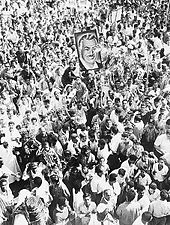
On 11 July, Nasser replaced Amer with Mohamed Fawzi as general commander,[223][224] to the protestations of Amer's loyalists in the military, 600 of whom marched on army headquarters and demanded Amer's reinstatement.[225] After Nasser sacked thirty of the loyalists in response,[225] Amer and his allies devised a plan to topple him on 27 August.[226] Nasser was tipped off about their activities and after several invitations, he convinced Amer to meet him at his home on 24 August.[226] Nasser confronted Amer about the coup plot, which he denied, and had Amer arrested by Mohieddin. Amer committed suicide on 14 September.[227] Despite his souring relationship with Amer, Nasser spoke of losing "the person closest to [him]".[228] Thereafter, Nasser began a process of depoliticizing the armed forces, arresting dozens of leading military and intelligence figures loyal to Amer.[227]
At the 29 August Arab League summit in Khartoum, Nasser's usual commanding position had receded as the attending heads of state expected Saudi King Faisal to lead. A ceasefire in the Yemen War was declared and the summit concluded with the Khartoum Resolution.[229] The USSR soon resupplied the Egyptian military with about half of its former arsenals and broke diplomatic relations with Israel. Nasser cut relations with the US following the war, and, according to Aburish, Nasser's policy of "playing the superpowers against each other" ended.[230] In November, Nasser accepted UN Resolution 242, which called for Israel's withdrawal from territories acquired in the war. His supporters claimed Nasser's move was meant to buy time to prepare for another confrontation with Israel, while his detractors believed his acceptance of the resolution signaled a waning interest in Palestinian independence.[231]
Final years of presidency
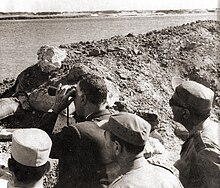
Domestic reforms and governmental changes
Nasser appointed himself the additional roles of prime minister and supreme commander of the armed forces on 19 June 1967.[232] In late February, workers and students launched demonstrations to protest the state's perceived leniency towards four Egyptian Air Force officers who were charged with negligence during the Six-Day War.[233][234] Nasser responded to the demonstrations, the most significant public challenge to his rule since workers' protests in March 1954, by removing most military figures from his cabinet and appointing eight civilians in place of several high-ranking members of the Arab Socialist Union (ASU).[235][236] By 3 March, Egypt's intelligence apparatus focused on external rather than domestic espionage and Nasser declared the "fall of the mukhabarat state".[236]
On 30 March, Nasser proclaimed a manifesto stipulating the restoration of civil liberties, greater parliamentary independence from the executive,[234] major structural changes to the ASU, and a campaign to rid the government of corrupt elements.[235] A public referendum approved the proposed measures in May, and held subsequent elections for the Supreme Executive Committee, the ASU's highest decision-making body.[234] Observers noted that the declaration signaled an important shift from political repression to liberalization, although its promises would largely go unfulfilled.[235]
Nasser appointed Sadat and Hussein el-Shafei as his vice presidents in December 1969. By then, relations with his other original military comrades, namely Khaled and Zakaria Mohieddin and former vice president Sabri, had become strained.[237] By mid-1970, Nasser pondered replacing Sadat with Boghdadi after reconciling with the latter.[238]
War of Attrition and regional diplomatic initiatives
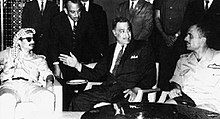
Meanwhile, in January 1968, Nasser commenced the War of Attrition to reclaim territory captured by Israel, ordering attacks against Israeli positions east of the then-blockaded Suez Canal.[239] In March, Nasser offered Yasser Arafat's Fatah movement arms and funds after their performance against Israeli forces in the Battle of Karameh that month.[240] He also advised Arafat to think of peace with Israel and the establishment of a Palestinian state comprising the West Bank and the Gaza Strip.[240] Nasser effectively ceded his leadership of the "Palestine issue" to Arafat.[231]
Israel retaliated against Egyptian shelling by heavily bombing Egyptian cities along the Suez Canal's western bank, causing a large exodus of Egyptians from that area.[241][242][243] Nasser ceased all military activities and began a program to build a network of internal defenses, while receiving the financial backing of various Arab states.[243] The war resumed in March 1969.[243] In November, Nasser brokered an agreement between the PLO and the Lebanese military that granted Palestinian guerrillas the right to use Lebanese territory to attack Israel.[244]
In June 1970, Nasser accepted the US-sponsored Rogers Plan, which called for an end to hostilities and an Israeli withdrawal from Egyptian territory, but it was rejected by Israel, the PLO, and most Arab states except Jordan.[238] Nasser had initially rejected the plan, but conceded under pressure from the USSR, which feared that escalating regional conflict could drag it into a war with the US.[245][246] He also determined a ceasefire could serve as a tactical step toward the strategic goal of recapturing the Suez Canal.[247] Following Nasser's acceptance, Israel agreed to a ceasefire and Nasser used the lull in fighting to move SAM missiles towards the canal zone.[245][246]
Meanwhile, tensions in Jordan between an increasingly autonomous PLO and King Hussein's government had been simmering,[248] and following the Dawson's Field hijackings, a military campaign was launched to rout out PLO forces. The offensive elevated risks of a regional war and prompted Nasser to hold an emergency Arab League summit on 27 September,[249] where he forged a ceasefire.[250]
Death and funeral
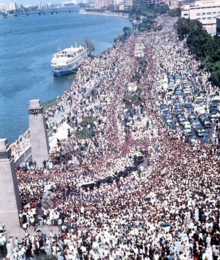
As the summit closed 28 September 1970, hours after escorting the last Arab leader to leave, Nasser suffered a heart attack. He was immediately transported to his house, where his physicians tended to him. Nasser died several hours later around 6:00 p.m.[251] Heikal, Sadat, and Nasser's wife Tahia were at his deathbed.[249] Following the announcement of Nasser's death, Egypt and the Arab world were in a state of shock.[249] According to his doctor, al-Sawi Habibi, Nasser's likely cause of death was arteriosclerosis, varicose veins, and complications from long-standing diabetes. Nasser was a heavy smoker with a family history of heart disease—two of his brothers died in their fifties from the same condition.[252] The state of Nasser's health was not known to the public prior to his death.[252][253]
Nasser's funeral procession through Cairo on 1 October was attended by at least five million mourners.[254][255] The 10-kilometre (6.2 mi) procession to his burial site began at the old RCC headquarters with a flyover by MiG-21 jets. His flag-draped coffin was attached to a gun carriage pulled by six horses and led by a column of cavalrymen.[255] All Arab heads of state attended, with the exception of Saudi King Faisal.[256] Jordanian King Hussein and PLO chairman Arafat cried openly, and Muammar Gaddafi of Libya fainted from emotional distress twice.[254] A few major non-Arab dignitaries were present, including Soviet Premier Alexei Kosygin and French Prime Minister Jacques Chaban-Delmas.[254]
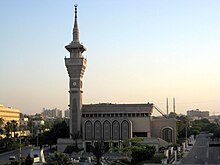
Almost immediately after the procession began, mourners engulfed Nasser's coffin chanting, "There is no God but Allah, and Nasser is God's beloved ... Each of us is Nasser."[255] Police unsuccessfully attempted to quell the crowds and as a result, most of the foreign dignitaries surrounding were evacuated.[255] The final destination was the Nasr Mosque, which was afterwards renamed Abdel Nasser Mosque, where Nasser was buried.[255]
Because of his ability to motivate nationalistic passions, "men, women, and children wept and wailed in the streets" after hearing of his death, according to Nutting.[251] The general Arab reaction was one of mourning, with thousands of people pouring onto the streets of major cities throughout the Arab world.[255] Over a dozen people were killed in Beirut as a result of the chaos, and in Jerusalem, roughly 75,000 Arabs marched through the Old City chanting, "Nasser will never die."[255] As a testament to his unchallenged leadership of the Arab people, following his death, the headline of the Lebanese As-Safir stated, "One hundred million human beings—the Arabs—are orphans."[254] Sherif Hetata, a former political prisoner[257] and later member of the ASU under Nasser,[258] said that "Nasser's greatest achievement was his funeral. The world will never again see five million people crying together."[254]
Legacy
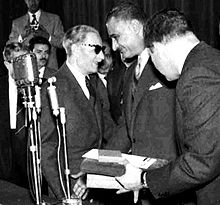
Nasser transitioned Egypt from British-occupation to serving as an influential power in the developing world.[259] One of Nasser's main domestic efforts was to establish social justice, which he deemed a prerequisite to liberal democracy.[260] During his presidency, ordinary citizens enjoyed unprecedented access to housing, education, jobs, health services, and nourishment as well as other forms of social welfare while feudalistic influence waned.[259][261] By the end of his presidency, employment and working conditions improved considerably, although poverty was still high in the country and substantial resources allocated for social welfare had been diverted to the war effort.[260]
The national economy grew significantly through agrarian reform, major modernization projects such as the Helwan steel works and the Aswan Dam, and nationalization schemes such as that of the Suez Canal.[259][261] However, the marked economic growth of the early 1960s took a downturn for the remainder of the decade, only recovering in 1970.[262] Egypt experienced a golden age of culture during his presidency, particularly in film, television, theater, radio, literature, fine arts, comedy, poetry, and music.[261][263] Egypt under Nasser dominated the Arab world in these fields,[261][263] producing cultural icons.[261]
During Mubarak's presidency, Nasserist political parties began to emerge in Egypt, the first being the Arab Democratic Nasserist Party (ADNP).[264][265] The party carried minor political influence,[266] and splits between its members beginning in 1995 resulted in the gradual establishment of splinter parties,[267] including Hamdeen Sabahi's 1997 founding of Al-Karama.[268] Sabahi came in third place during the 2012 presidential election.[269] Nasserist activists were among the founders of Kefaya, a major opposition force during Mubarak's rule.[268] On 19 September 2012, four Nasserist parties (the ADNP, Karama, the National Conciliation Party, and the Popular Nasserist Congress Party) merged to form the United Nasserist Party.[270]
Image
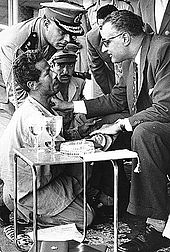
Nasser was noted for his intimate relationship with ordinary Egyptians.[271][272] His availability to the public, despite assassination attempts against him, was unparalleled among his successors.[273] Between 1953 and 1970, he made 1,359 speeches, a record for any Egyptian head of state.[274] Historian Elie Podeh wrote that a constant theme of Nasser's image was "his ability to represent Egyptian authenticity, in triumph or defeat".[271] The national press also helped to foster his popularity and profile—more so after the nationalization of state media.[273] Historian Tarek Osman wrote:
The interplay in the Nasser 'phenomenon' between genuine expression of popular feeling and state-sponsored propaganda may sometimes be hard to disentangle. But behind it lies a vital historical fact: that Gamal Abdel Nasser signifies the only truly Egyptian developmental project in the country's history since the fall of the Pharoanic [sic] state. There had been other projects ... But this was different—in origin, meaning and impact. For Nasser was a man of the Egyptian soil who had overthrown the Middle East's most established and sophisticated monarchy in a swift and bloodless move—to the acclaim of millions of poor, oppressed Egyptians—and ushered in a programme of 'social justice', 'progress and development', and 'dignity'.[275]
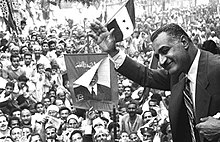
While Nasser was the object of Egyptian intellectual criticism following the Six-Day War and his death in 1970, the general public was persistently sympathetic both during and after Nasser's life.[271] According to political scientist Mahmoud Hamad, writing in 2008, "nostalgia for Nasser is easily sensed in Egypt and all Arab countries today".[276] General malaise in Egyptian society, particularly during the Mubarak era, augmented nostalgia for Nasser's presidency, which increasingly became associated with the ideals of national purpose, hope, social cohesion, and vibrant culture.[263]
Until the present day, Nasser serves as an iconic figure throughout the Arab world,[259][277] a symbol of Arab unity and dignity,[278][279][280] and a towering figure in modern Middle Eastern history.[25] He is also considered a champion of social justice in Egypt.[281][282] Time writes that despite his mistakes and shortcomings, Nasser "imparted a sense of personal worth and national pride that [Egypt and the Arabs] had not known for 400 years. This alone may have been enough to balance his flaws and failures."[255]
Historian Steven A. Cook wrote in July 2013, "Nasser's heyday still represents, for many, the last time that Egypt felt united under leaders whose espoused principles met the needs of ordinary Egyptians."[283] During the Arab Spring, which resulted in a revolution in Egypt, photographs of Nasser were raised in Cairo and Arab capitals during anti-government demonstrations.[284][285] According to journalist Lamis Andoni, Nasser had become a "symbol of Arab dignity" during the mass demonstrations.[284]
Criticism
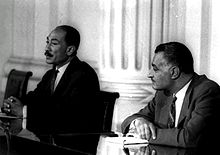
Sadat declared his intention to "continue the path of Nasser" in his 7 October 1970 presidential inauguration speech,[286] but began to depart from Nasserist policies as his domestic position improved following the 1973 October War.[266][286] President Sadat's Infitah policy sought to open Egypt's economy for private investment.[287] According to Heikal, ensuing anti-Nasser developments until the present day led to an Egypt "[half] at war with Abdel-Nasser, half [at war] with Anwar El-Sadat".[261]
Nasser's Egyptian detractors considered him a dictator who thwarted democratic progress, imprisoned thousands of dissidents, and led a repressive administration responsible for numerous human rights violations.[261] Islamists in Egypt, particularly members of the Brotherhood, viewed Nasser's political persecution as oppressive, tyrannical, and demonic.[288] Liberal writer Tawfiq al-Hakim described Nasser as a "confused Sultan" who employed stirring rhetoric, but had no actual plan to achieve his stated goals.[287]
Some of Nasser's liberal and Islamist critics in Egypt, including the founding members of the New Wafd Party and writer Jamal Badawi, dismissed Nasser's popular appeal with the Egyptian masses during his presidency as being the product of successful manipulation and demagoguery.[289] Egyptian political scientist Alaa al-Din Desouki blamed the 1952 revolution's shortcomings on Nasser's concentration of power, and Egypt's lack of democracy on Nasser's political style and his government's limitations on freedom of expression and political participation.[290]
American political scientist Mark Cooper asserted that Nasser's charisma and his direct relationship with the Egyptian people "rendered intermediaries (organizations and individuals) unnecessary".[291] He opined that Nasser's legacy was a "guarantee of instability" due to Nasser's reliance on personal power and the absence of strong political institutions under his rule.[291]
Regional leadership
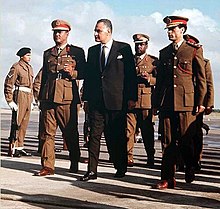
Through his actions and speeches, and because he was able to symbolize the popular Arab will, Nasser inspired several nationalist revolutions in the Arab world.[275] Nasser defined the politics of his generation.[289] Unable to meet his stature or impact, no contemporary Arab leader has been able to assume Nasser's regional leadership position.[289] He communicated directly with the public masses of the Arab world, bypassing the various heads of states of those countries—an accomplishment not repeated by other Arab leaders.[289] The extent of Nasser's centrality in the region made it a priority for incoming Arab nationalist heads of state to seek good relations with Egypt, in order to gain popular legitimacy from their own citizens.[292]
To varying degrees,[25] Nasser's statist system of government was continued in Egypt and emulated by virtually all Arab republics,[293] namely Algeria, Syria, Iraq, Tunisia, Yemen, Sudan, and Libya.[25][293] Ahmed Ben Bella, Algeria's first president, was a staunch Nasserist.[294] Abdullah al-Sallal drove out the king of North Yemen in the name of Nasser's pan-Arabism.[170] Other coups influenced by Nasser included those that occurred in Iraq in July 1958 and Syria in 1963.[295] Muammar Gaddafi, who overthrew the Libyan monarchy in 1969, considered Nasser his hero and sought to succeed him as "leader of the Arabs".[296] Also in 1969, colonel Gaafar Nimeiry, a supporter of Nasser, took power in Sudan.[297] The Arab Nationalist Movement (ANM) helped spread Nasser's pan-Arabist ideas throughout the Arab world, particularly among the Palestinians,[298][299] and in South Yemen, the Persian Gulf, and Iraq.[299] While many regional heads of state tried to emulate Nasser, Podeh opined that the "parochialism" of successive Arab leaders "transformed imitation [of Nasser] into parody".[293]
Portrayal in film
In 1963, Egyptian director Youssef Chahine produced the film El Nasser Salah El Dine ("Saladin The Victorious"), which intentionally drew parallels between Saladin, considered a hero in the Arab world, with Nasser and his pan-Arabist policies.[300] Nasser is played by Ahmed Zaki in Mohamed Fadel's 1996 Nasser 56. The film set the Egyptian box office record at the time, and centered on Nasser during the Suez Crisis.[301][302] It is also considered a milestone in Egyptian and Arab cinema as the first film to dramatize the role of a modern-day Arab leader.[303] Together with the 1999 Syrian biopic Gamal Abdel Nasser, the films marked the first biographical movies about contemporary public figures produced in the Arab world.[304]
Personal life
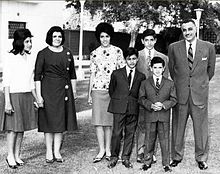
In 1944, Nasser married Tahia Kazim, the 22-year-old daughter of a wealthy Iranian father and an Egyptian mother, both of whom died when she was young. She was introduced to Nasser through her brother, Abdel Hamid Kazim, a merchant friend of Nasser's, in 1943.[305] After their wedding, the couple moved into a house in Manshiyat al-Bakri, a suburb of Cairo, where they would live for the rest of their lives. Nasser's entry into the officer corps in 1937 secured him relatively well-paid employment in a society where most people lived in poverty. His social status was still well below the wealthy Egyptian elite, and his resentment of those born into wealth and power continued to grow.[26]
Nasser and Tahia would sometimes discuss politics at home, but for the most part, Nasser kept his career separate from his family life. He preferred to spend most of his free time with his children.[306] Nasser and Tahia had two daughters and three sons: Hoda, Mona, Khaled, Abdel Hamid, and Abdel Hakim.[307]
Although he was a proponent of secular politics, Nasser was an observant Muslim who made the Hajj pilgrimage to Mecca in 1954 and 1965.[308][309] He was known to be personally incorruptible,[310][311][312][313] a characteristic which further enhanced his reputation among the citizens of Egypt and the Arab world.[312] Nasser's personal hobbies included photography, chess, magazines in Arabic, English, and French, American films, and classical music.[314]
Nasser had few personal vices other than chain smoking.[252][311][315] He maintained 18-hour workdays and rarely took time off for vacations. The combination of smoking and working long hours contributed to his poor health. He was diagnosed with diabetes in the early 1960s and by the time of his death in 1970, he also had arteriosclerosis, heart disease, and high blood pressure. He suffered two major heart attacks (in 1966 and 1969), and was on bed rest for six weeks after the second episode. State media reported that Nasser's absence from the public view at that time was a result of influenza.[252]
Writings
Nasser wrote the following books, published during his lifetime:[316]
- Memoirs of the First Palestine War (Arabic: يوميات الرئيس جمال عبد الناصر عن حرب فلسطين) (1955; Akher Sa'a)
- "Memoirs of the First Palestine War", in 2, no. 2 (Win. 73): 3–32 (First English translation, 1973, pdf-file from Journal of Palestine Studies)
- Egypt's Liberation: The Philosophy of the Revolution (Arabic: فلسفة الثورة) (1955; Dar al-Maaref)
- Towards Freedom (Arabic: في سبيل الحرية) (1959; Cairo-Arabian Company)
See also
References
- ^ a b c Vatikiotis 1978, pp. 23–24
- ^ Joesten 1974, p. 14
- ^ a b Stephens 1972, p. 23
- ^ Aburish 2004, pp. 12–13
- ^ Stephens 1972, p. 26
- ^ a b Stephens 1972, pp. 28–32
- ^ a b c d e Alexander 2005, p. 14
- ^ a b c d e f g h i j k l m n Abdel Nasser, Hoda. "A Historical Sketch of Gamal Abdel Nasser". Bibliotheca Alexandrina. Retrieved 23 July 2013.
- ^ Aburish 2004, pp. 8–9
- ^ Vatikiotis 1978, p. 24
- ^ Stephens 1972, pp. 33–34
- ^ Joesten 1974, p. 19
- ^ a b c d Litvin 2011, p. 39
- ^ a b Alexander 2005, p. 15
- ^ Joesten 1974, p. 66
- ^ a b Alexander 2005, pp. 19–20
- ^ Stephens 1972, p. 32
- ^ a b Aburish 2004, pp. 11–12
- ^ a b c Alexander 2005, p. 16
- ^ "The Books Gamal Abdel Nasser Used to Read, 1. During his Secondary School Years". Bibliotheca Alexandrina. Retrieved 20 August 2013.
- ^ Talhami 2007, p. 164
- ^ a b c d Aburish 2004, pp. 15–16
- ^ a b c d Alexander 2005, p. 20
- ^ Reid 1981, p. 158
- ^ a b c d Cook 2011, p. 41
- ^ a b c d Alexander 2005, pp. 26–27
- ^ a b c Aburish 2004, p. 18
- ^ Nutting 1972, p. 20
- ^ Aburish 2004, p. 22
- ^ Stephens 1972, p. 63
- ^ a b Aburish 2004, p. 23
- ^ Aburish 2004, p. 24
- ^ a b c d Aburish 2004, pp. 25–26
- ^ Heikal 2004, p. 103
- ^ a b Brightman 2004, p. 233
- ^ Dokos 2007, p. 114
- ^ Pollack 2002, p. 27
- ^ a b Heikal 1973, p. 17
- ^ a b c d e f g h i Aburish 2004, pp. 27–28
- ^ Aburish 2004, p. 30
- ^ a b Aburish 2004, p. 32
- ^ a b c Aburish 2004, p. 33
- ^ a b c d e f Aburish 2004, p. 34
- ^ a b Aburish 2004, pp. 34–35
- ^ a b c d Aburish 2004, pp. 35–39
- ^ Nutting 1972, pp. 36–37
- ^ Stephens 1972, p. 108
- ^ a b Aburish 2004, p. 41
- ^ Nutting 1972, pp. 38–39
- ^ a b Dekmejian 1971, p. 24
- ^ Stephens 1972, p. 114
- ^ Aburish 2004, p. 46
- ^ a b Aburish 2004, p. 45
- ^ a b c d Aburish 2004, pp. 46–47
- ^ Kandil 2012, p. 22
- ^ Kandil 2012, p. 23
- ^ a b c d Aburish 2004, p. 51
- ^ a b Kandil 2012, p. 27
- ^ a b c Kandil 2012, p. 32
- ^ Nutting 1972, p. 60
- ^ Kandil 2012, p. 33
- ^ Kandil 2012, p. 34
- ^ a b c Kandil 2012, p. 35
- ^ Aburish 2004, p. 52
- ^ Kandil 2012, p. 36
- ^ Kandil 2012, p. 38
- ^ a b c Kandil 2012, p. 39
- ^ Aburish 2004, pp. 52–53
- ^ Aburish 2004, pp. 54–55
- ^ a b c Rogan 2011, p. 228
- ^ a b c d Aburish 2004, p. 54
- ^ Brown 2000, p. 159
- ^ a b c d e Aburish 2004, p. 56
- ^ a b Atiyeh & Oweis 1988, pp. 331–332
- ^ Jankowski 2001, p. 32
- ^ Aburish 2004, p. 239
- ^ a b c d e Rasler, Thompson & Ganguly 2013, pp. 38–39
- ^ a b c d e Dekmejian 1971, p. 44
- ^ Kandil 2012, pp. 45–46
- ^ a b Tan & Acharya 2008, p. 12
- ^ a b Dekmejian 1971, p. 43
- ^ Ginat 2010, p. 115
- ^ Ginat 2010, p. 113
- ^ a b Jankowski 2001, pp. 65–66
- ^ Ginat 2010, p. 105
- ^ Ginat 2010, p. 111
- ^ Cook 2011, p. 66
- ^ Ginat 2010, pp. 111–112
- ^ a b c d e Jankowski 2001, p. 67
- ^ Alexander 2005, p. 126
- ^ a b Ansari 1986, p. 84
- ^ a b Peretz 1994, p. 242
- ^ Peretz 1994, p. 241
- ^ Sullivan 1986, p. 80
- ^ a b c Dekmejian 1971, p. 45
- ^ James 2008, p. 149
- ^ a b c d James 2008, p. 150
- ^ a b Goldschmidt 2008, p. 162
- ^ a b c d e f Jankowski 2001, p. 68
- ^ a b "1956: Egypt Seizes Suez Canal". BBC News. 26 July 1956. Retrieved 4 March 2007.
- ^ a b Aburish 2004, p. 108
- ^ Hamad 2008, p. 96
- ^ Rogan 2011, p. 299
- ^ Heikal 1973, p. 91
- ^ Heikal 1973, pp. 103–104
- ^ Heikal 1973, p. 105
- ^ Shlaim, Avi (1997). "The Protocol of Sèvres,1956: Anatomy of a War Plot". International Affairs. 73:3: 509–530. Retrieved 6 October 2009.
- ^ Dawisha 2009, p. 179
- ^ Jankowski 2001, p. 66
- ^ Kandil 2012, p. 47
- ^ a b c Aburish 2004, pp. 118–119
- ^ a b c d e Shemesh & Troen 1990, p. 116
- ^ a b c Bidwell 1998, p. 398
- ^ Dekmejian 1971, p. 46
- ^ a b Alexander 2005, p. 94
- ^ a b c Kyle 2011, pp. 445–446
- ^ a b Kyle 2001, pp. 113–114
- ^ a b Yaqub 2004, p. 51
- ^ Dawisha 2009, p. 180
- ^ "Establishment of UNEF (United Nations Emergency Force)". United Nations. Retrieved 29 July 2010.
- ^ Beinin 2005, p. 87
- ^ Aburish 2004, p. 123
- ^ a b Dawisha 2009, p. 184
- ^ Rogan 2011, p. 305
- ^ a b c Aburish 2004, pp. 135–136
- ^ a b c Aburish 2004, p. 127
- ^ a b Yaqub 2007, p. 102
- ^ Dawisha 2009, p. 155
- ^ a b c d Dawisha 2009, pp. 181–182
- ^ a b Dawisha 2009, p. 191
- ^ Dann 1989, p. 169
- ^ Aburish 2004, p. 130
- ^ Aburish 2004, pp. 130–131
- ^ a b c d e f Aburish 2004, pp. 138–139
- ^ a b c Dawisha 2009, pp. 191–192
- ^ a b Dawisha 2009, pp. 193
- ^ Dawisha 2009, p. 198
- ^ Dawisha 2009, pp. 199–200
- ^ Dawisha 2009, p. 200
- ^ Aburish 2004, pp. 150–151
- ^ Podeh 1999, pp. 44–45
- ^ a b Dawisha 2009, pp. 202–203
- ^ Aburish 2004, p. 158
- ^ Dawisha 2009, p. 190
- ^ Aburish 2004, pp. 160–161
- ^ a b c Aburish 2004, pp. 161–162
- ^ Aburish 2004, p. 163
- ^ a b Aburish 2004, pp. 174–175
- ^ a b Dawisha 2009, p. 208
- ^ Aburish 2004, p. 164
- ^ United Nations observers reported no significant military support was sent to Lebanon from the UAR. See Dawisha 2009, pp. 208-209 and Aburish 2004, p. 167.
- ^ Aburish 2004, p. 166
- ^ a b Dawisha 2009, p. 209
- ^ a b Aburish 2004, pp. 169–170
- ^ Aburish 2004, p. 172
- ^ a b c d Aburish 2004, pp. 176–178
- ^ a b Salam 2004, p. 102
- ^ a b Aburish 2004, pp. 181–183
- ^ Dawisha 2009, p. 216
- ^ Aburish 2004, pp. 179–180
- ^ Dawisha 2009, p. 227
- ^ a b Dawisha 2009, p. 231
- ^ Dawisha 2009, p. 229
- ^ a b Aburish 2004, pp. 189–191
- ^ Dawisha 2009, p. 230
- ^ a b c d e Aburish 2004, pp. 204–205
- ^ a b Podeh 2004, p. 157
- ^ a b Aburish 2004, pp. 205–206
- ^ Abdelmalek 1968, pp. 363–365
- ^ a b c Aburish 2004, pp. 207–208
- ^ a b c Dawisha 2004, p. 235
- ^ a b c d Aburish 2004, pp. 209–211
- ^ Dawisha 2004, p. 237
- ^ Seale 1990, pp. 76–77
- ^ a b c Aburish 2004, pp. 215–217
- ^ Dawisha 2004, p. 239
- ^ Seale 1990, p. 81
- ^ Seale 1990, pp. 82–83
- ^ a b Dawisha 2004, pp. 243–244
- ^ a b c d e Aburish 2004, pp. 222–223
- ^ a b Cubert 1997, p. 52
- ^ Mehrotra 1990, p. 57
- ^ Mehrotra 1990, p. 58
- ^ Aburish 2004, p. 234
- ^ Marchevsky & Theoharis 2006, p. 151
- ^ a b c Adi & Sherwood 2003, pp. 140–141
- ^ a b c d Aburish 2004, pp. 200–201
- ^ a b c d Aburish 2004, pp. 235–237
- ^ Kandil 2012, p. 51
- ^ a b c Farid 1996, p. 71
- ^ a b c Brooks 2004, p. 88
- ^ Brooks 2004, p. 89
- ^ Farid 1996, pp. 71–72
- ^ Aburish 2004, p. 244
- ^ Stork 2001, pp. 235–236
- ^ Akram-Lodhi, Borras & Kay 2007, pp. 258–259
- ^ a b Aburish 2004, pp. 238–239
- ^ Cook 2011, p. 123
- ^ Aburish 2004, p. 258
- ^ a b Aburish 2004, p. 252
- ^ a b Kandil 2012, p. 76
- ^ Brooks 2008, p. 90
- ^ a b c d e Kandil 2012, p. 77
- ^ Parker 1996, p. 159
- ^ Parker 1996, pp. 158–159
- ^ a b Aburish 2004, pp. 254–255
- ^ a b Brooks 2008, p. 95
- ^ Kandil 2012, pp. 77–78
- ^ Aburish 2004, p. 255
- ^ a b Kandil 2012, p. 86
- ^ a b Aburish 2004, p. 257
- ^ a b Brooks 2008, p. 97
- ^ Aburish 2004, p. 258
- ^ Aburish 2004, pp. 252–254
- ^ Aburish 2004, p. 256
- ^ a b c Aburish 2004, pp. 260–261
- ^ Kandil 2012, p. 82
- ^ a b Aburish 2004, p. 263
- ^ a b c Aburish 2004, p. 262
- ^ a b Bidwell 1998, p. 276
- ^ Kandil 2012, p. 84
- ^ a b Aburish 2004, pp. 268–269
- ^ Kandil 2012, p. 85
- ^ Nutting 1972, p. 430
- ^ a b Kandil 2012, p. 87
- ^ a b Kandil 2012, p. 88
- ^ a b Kandil 2012, pp. 89–90
- ^ Aburish 2004, p. 277
- ^ Aburish 2004, pp. 270–271
- ^ Aburish 2004, p. 272
- ^ a b Aburish 2004, p. 281
- ^ Aburish 2004, p. 276
- ^ Brownlee 2007, p. 88
- ^ a b c Farid 1996, p. 97
- ^ a b c Brownlee 2007, p. 89
- ^ a b Kandil 2012, p. 92
- ^ Aburish 2004, pp. 299–301
- ^ a b Aburish 2004, p. 304
- ^ Aburish 2004, p. 280
- ^ a b Aburish 2004, pp. 288–290
- ^ Byman & Waxman 2002, p. 66
- ^ Rasler, Thompson & Ganguly 2010, p. 49
- ^ a b c Aburish 2004, pp. 297–298
- ^ Aburish 2004, p. 301
- ^ a b Aburish 2004, pp. 305
- ^ a b Viorst 1987, p. 133
- ^ Farid 1996, p. 163
- ^ Dawisha 2009, p. 259
- ^ a b c Aburish 2004, pp. 309–310 Cite error: The named reference "Aburish310" was defined multiple times with different content (see the help page).
- ^ Dawisha 2009, p. 262
- ^ a b Nutting 1972, p. 476
- ^ a b c d Daigle 2012, p. 115
- ^ "Claims that Sadat killed Nasser are unfounded". Al Arabiya. 26 September 2010. Retrieved 27 January 2011.
- ^ a b c d e Aburish 2004, pp. 315–316
- ^ a b c d e f g h "Nasser's Legacy: Hope and Instability". Time. 12 October 1970. Retrieved 3 May 2010.
- ^ Weston 2008, p. 203
- ^ Botman 1988, p. 72
- ^ Nelson 1988, p. 72
- ^ a b c d Cook 2011, p. 111
- ^ a b Darling 2013, p. 192
- ^ a b c d e f g Shukrallah, Hani; Guindy, Hosny (4 November 2000). "Liberating Nasser's Legacy". Al-Ahram Weekly. Al-Ahram. Retrieved 23 November 2009.
- ^ Cook 2011, p. 112
- ^ a b c Gordon 2000, p. 171
- ^ Bernard-Maugiron 2008, p. 220
- ^ Brynen, Korany & Noble 1995, p. 50
- ^ a b Podeh 2004, p. 100
- ^ El-Nahhas, Mona (18 October 2000). "Nasserism's potential untapped". Al-Ahram Weekly. No. 503. Retrieved 10 June 2013.
- ^ a b "Egypt Elections Watch: Al-Karama". Ahram Online and Jadaliyya. 18 November 2011. Retrieved 11 June 2013.
- ^ "Egypt candidate to seek election suspension". Al Jazeera English. Al-Jazeera. 27 May 2012. Retrieved 10 June 2013.
- ^ "Nasserist groups announce new, unified political party". Egypt Independent. Al-Masry Al-Youm. 20 September 2012. Retrieved 11 June 2013.
- ^ a b c Podeh 2004, pp. 67–68
- ^ Hamad 2008, pp. 100–101
- ^ a b Golia, Maria (23 July 2011). "Kings never die: A tale of a devoted iconography". Egypt Independent. Al-Masry Al-Youm. Retrieved 30 June 2013.
- ^ Hamad 2008, p. 99
- ^ a b Osman 2011, p. 42
- ^ Hamad 2008, p. 100
- ^ Hardy, Roger (26 July 2006). "How Suez made Nasser an Arab icon". BBC News. BBC MMIX. Retrieved 23 November 2009.
- ^ Hourani 2002, p. 369
- ^ Seale 1990, p. 66
- ^ Dekmeijan 1971, p. 304
- ^ Al Sherbini, Ramadan (23 July 2012). "Anniversary heightens face-off with Muslim Brotherhood". Gulf News. Al Nisr Publishing LLC. Retrieved 18 August 2013.
- ^ Stephens, Robert (1981), "Makers of the Twentieth Century: Nasser", History Today, vol. 31, no. 2, History Today, Ltd., retrieved 18 August 2013
- ^ Cook, Steven (25 July 2013). "A Faustian Pact: Generals as Democrats". The New York Times. The New York Times Company, Inc. Retrieved 18 August 2013.
- ^ a b Andoni, Lamis (11 February 2011). "The resurrection of pan-Arabism". Al-Jazeera English. Al-Jazeera. Retrieved 15 February 2011.
- ^ El-Tonsi, Ahmed (16 January 2013). "The legacy of Nasserism". Al-Ahram Weekly. Retrieved 1 July 2013.
- ^ a b Cooper 1982, p. 67
- ^ a b Osman 2011, p. 44
- ^ Podeh 2004, p. 61
- ^ a b c d Podeh 2004, pp. ix–x
- ^ Podeh 2004, p. 50
- ^ a b Cooper 1982, p. 64
- ^ Dawisha 2009, p. 151
- ^ a b c Podeh 2004, p. 47
- ^ Abdel-Malek, Anouar (1964). "The Socialist Register". The Socialist Register. 1: 52. Retrieved 26 November 2009.
{{cite journal}}:|chapter=ignored (help) - ^ Asterjian 2007, p. 52
- ^ Fetini, Alyssa (3 February 2009). "Muammar Gaddafi". Time. Retrieved 24 November 2009.
- ^ Rubin 2010, p. 41
- ^ Kimmerling & Migdal 2003, p. 225
- ^ a b Dawisha 2009, p. 156
- ^ Haydock & Risden 2009, p. 110
- ^ Gordon 2000, p. 161
- ^ Young, Gayle (24 October 1996). "Nasser film strikes chord with the people of Egypt". CNN. Cable News Network, Inc. Retrieved 23 July 2013.
- ^ Hourani & Khoury 2004, p. 599
- ^ Karawya, Fayrouz (29 August 2011). "Biopics in the Arab world: History entangled with subjectivity". Egypt Independent. Al-Masry Al-Youm. Retrieved 10 June 2013.
- ^ Sullivan 1986, p. 84
- ^ Sullivan 1986, p. 85
- ^ Aburish 2004, pp. 313–320
- ^ Aburish 2004, p. 148
- ^ Alexander 2005, p. 74
- ^ Makdisi 2011, p. 217
- ^ a b Bird 2010, p. 177
- ^ a b Goldschmidt 2008, p. 167
- ^ Alexander 2005, p. 97
- ^ Bird 2010, p. 178
- ^ Aburish 2004, p. 10
- ^ "Gamal Abdel Nasser Writings". Bibliotheca Alexandrina. Retrieved 24 June 2013.
Bibliography
- Abdelmalek, Anwar (1968), Egypt: Military Society, New York City: Random House, OCLC 314333504
- Aburish, Said K. (2004), Nasser, the Last Arab, New York City: St. Martin's Press, ISBN 978-0-312-28683-5
- Adi, Hakim; Sherwood, Marika (2003), Pan-African History: Political Figures from Africa and the Diaspora since 1787, Routledge, ISBN 0-415-17352-3
- Alexander, Anne (2005), Nasser Life and Times (illustrated ed.), Haus Publishing, ISBN 978-1-904341-83-3
- Akram-Lodhi, Haroon; Borras, Saturnino M.; Kay, Cristóbal (2007), Land, Poverty and Livelihoods in an Era of Globalization: Perspectives from Developing and Transition Countries, Routledge, ISBN 978-0-415-41449-4
- Ansari, Hamied (1986), Egypt: The Stalled Society, SUNY Press, ISBN 9780791494998
- Asterjian, Henry D. (2007), The Struggle for Kirkuk: The Rise of Hussein, Oil, and the Death of Tolerance in Iraq, Greenwood Publishing Group, ISBN 0-275-99589-5
- Atiyeh, George Nicholas; Oweis, Ibrahim M. (1988), Arab Civilization: Challenges and Responses, SUNY Press, ISBN 9780791495414
- Bard, Mitchell G. (2008), The Complete Idiot's Guide to Middle East Conflict, Penguin Group, ISBN 1-59257-791-1
- Beinin, Joel (2005), The Dispersion of Egyptian Jewry: Culture, Politics, and the Formation of a Modern Diaspora, American University in Cairo Press, ISBN 977-424-890-2
- Bernard-Maugiron, Nathalie (2008), Judges and Political Reform in Egypt, American University in Cairo Press, ISBN 978-977-416-201-5
- Bidwell, Robin (1998), Dictionary Of Modern Arab History, Routledge, ISBN 0-7103-0505-2
- Bird, Kai (2010), Crossing Mandelbaum Gate: Coming of Age Between the Arabs and Israelis, 1956-1978, Simon and Schuster, ISBN 978-1-4165-4440-1
- Botman, Selma (1988), The Rise of Egyptian Communism, 1939-1970, Syracuse University Press, ISBN 9780815624431
- Brightman, Carol (2004), Total Insecurity: The Myth Of American Omnipotence, Verso Books, ISBN 1-84467-010-4
- Brooks, Risa (2008), Shaping Strategy: The Civil-military Politics of Strategic Assessment, Princeton University Press, ISBN 978-0-691-12980-8
- Brown, Leon Carl (2000), Religion and State: The Muslim Approach to Politics, Columbia University Press, ISBN 0-231-12038-9
- Brownlee, Jason (2007), Authoritarianism in an Age of Democratization, Cambridge University Press, ISBN 978-0-521-86951-5
- Brynen, Yaacov; Korany, Bahgat; Noble, Paul (1995), Political Liberalization and Democratization in the Arab World, vol. 1, Lynne Rienner Publishers, ISBN 1-55587-559-9
- Byman, Daniel; Waxman, Matthew (2002), The Dynamics of Coercion: American Foreign Policy and the Limits of Military Might, Cambridge University Press, ISBN 9780521007801
- Cook, Steven A. (2011), The Struggle for Egypt : From Nasser to Tahrir Square: From Nasser to Tahrir Square, Oxford University Press, ISBN 978-0-19-979526-0
- Cooper, Mark N. (1982), The Transformation of Egypt, Taylor & Francis, ISBN 0-7099-0721-4
- Cubert, Harold M. (1997), The PFLP's Changing Role in the Middle East, Psychology Press, ISBN 9780714647722
- Daigle, Craig (2012), The Limits of Detente: The United States, the Soviet Union, and the Arab–Israeli Conflict, 1969-1973, Yale University Press, ISBN 978-0-300-16713-9
- Darling, Linda T. (2013), A History of Social Justice and Political Power in the Middle East: The Circle of Justice From Mesopotamia to Globalization, Routledge, ISBN 9781136220180
- Dawisha, Adeed (2009), Arab Nationalism in the Twentieth Century: From Triumph to Despair, Princeton University Press, ISBN 0-691-10273-2
- Dekmejian, Richard Hrair (1971), Egypt Under Nasir: A Study in Political Dynamics, New York City: State University of New York Press, ISBN 978-0-87395-080-0
- Dokos, Thanos P. (2007), Security Sector Transformation in Southeastern Europe and the Middle East, IOS Press, ISBN 978-1-58603-757-4
- Farid, Abdel Magid (1996), Nasser: The Final Years, Garnet & Ithaca Press, ISBN 0-86372-211-3
- Ginat, Rami (2010), Syria and the Doctrine of Arab Neutralism: From Independence to Dependence, Sussex Academic Press, ISBN 978-1-84519-396-6
- Goldschmidt, Arthur (2008), A Brief History of Egypt, Infobase Publishing, ISBN 978-0-8160-6672-8
- Gordon, Joel (2000), "Nasser 56/Cairo 96: Reimaging Egypt's Lost Community", in Walter Armbrust (ed.), Mass Mediations: New Approaches to Popular Culture in the Middle East and Beyond (PDF), University of California Press, ISBN 0-520-21925-2
- Hamad, Mahmoud (2008), When the Gavel Speaks: Judicial Politics in Modern Egypt, ProQuest, ISBN 9781243976536
- Hart-Davis, Duff (2011), The War That Never Was: The True Story of the men who fought Britain's most secret battle, Century, ISBN 978-1-84605-825-7
- Haydock, Nickolas; Risden, Edward L. (2009), Hollywood in the Holy Land: Essays on Film Depictions of the Crusades and Christian-Muslim Clashes, McFarland and Company, ISBN 0-7864-4156-9
- Heikal, Mohamed Hassanein (1973), The Cairo Documents: The Inside Story of Nasser and His Relationship with World Leaders, Rebels, and Statesmen, New York City: Doubleday, ISBN 978-0-385-06447-7
- Hourani, Albert (2002), A History of the Arab Peoples, Harvard University Press, ISBN 0-674-01017-5
- Hourani, Albert; Khoury, Phillip Shukry (2004), The Modern Middle East: A Reader, I.B. Tauris, ISBN 1-86064-963-7
- James, Laura M. (2008), "When Did Nasser Expect War? The Suez Nationalization and its Aftermath in Egypt", in Simon C. Smith (ed.), Reassessing Suez 1956: New Perspectives on the Crisis and Its Aftermath, Ashgate Publishing, Ltd., ISBN 978-0-7546-6170-2
- Jankowski, James P. (2001), Nasser's Egypt, Arab Nationalism, and the United Arab Republic, Lynne Rienner Publishers, ISBN 1-58826-034-8
- Joesten, Joachim (1974), Nasser: The Rise to Power, Long Acre, London: Odhams Press Limited, OCLC 317256563
- Kandil, Hazem (2012), Soldiers, Spies and Statesmen: Egypt's Road to Revolt, Verso Books, ISBN 978-1-84467-962-1
- Kimmerling, Baruch; Migdal, Joel S. (2003), The Palestinian People: A History, Harvard University Press, ISBN 0-674-01129-5
- Kyle, Keith (2001), "Britain's Slow March to Suez", in David Tal (ed.), The 1956 War: Collusion and Rivalry in the Middle East, Psychology Press, ISBN 0-7146-4840-X
- Kyle, Keith (2011), Suez: Britain's End of Empire in the Middle East, I.B. Tauris, ISBN 978-1-84885-533-5
- Litvin, Margaret (2011), Hamlet's Arab Journey: Shakespeare's Prince and Nasser's Ghost, Princeton University Press, ISBN 978-0-691-13780-3
- Makdissi, Usama (2011), Faith Misplaced: The Broken Promise of U.S.-Arab Relations: 1820-2001, PublicAffairs, ISBN 978-1-58648-680-8
- Marchevsky, Alejandra; Theoharis, Jeanne (2006), Not Working: Latina Immigrants, Low-wage Jobs, And the Failure of Welfare Reform, NYU Press, ISBN 978-0-8147-5709-3
- Mehrotra, Raja R. (1990), Nehru: Man Among Men, Mittal Publications, ISBN 9788170991960
- Nutting, Anthony (1972), Nasser, New York City: E.P. Dutton, ISBN 978-0-525-16415-9
- Oron, Yitzhak (1960), Middle East Record Volume 1, 1960, The Moshe Dayan Center
- Osman, Tarek (2011), Egypt on the Brink: From Nasser to Mubarak, Yale University Press, ISBN 978-0-300-162752
- Parker, Richard Bordeaux (1996), The Six-Day War: A Retrospective, University Press of Florida, ISBN 9780813013831
- Peretz, Don (1994), The Middle East Today (6th ed.), Greenwood Publishing Group, ISBN 9780275945763
- Podeh, Elie (1999), The Decline of Arab Unity: The Rise and Fall of the United Arabic Republic, Sussex Academic Press, ISBN 1-902210-20-4
- Podeh, Elie (2004), Rethinking Nasserism: Revolution and Historical Memory in Modern Egypt, University Press of Florida, ISBN 0-8130-2704-7
- Pollack, Kenneth Michael (2002), Arabs at War: Military Effectiveness, 1948-1991, University of Nebraska Press, ISBN 0-8032-3733-2
- Rasler, Karen; William R., Thompson; Ganguly, Sumit (2013), How Rivalries End, University of Pennsylvania Press, ISBN 978-0-8122-4498-4
- Reid, Donald Malcolm (1981), Lawyers and Politics in the Arab World: 1880-1960, Bibliotheca Islamica, Inc., ISBN 978-0882970288
- Rogan, Eugene (2011), The Arabs: A History, Basic Books, ISBN 9780465028221
- Rubin, Barry (2010), Guide to Islamist Movements, M.E. Sharpe, ISBN 978-0-7656-1747-7
- Sachar, Howard M. (1976), A History of Israel from the Rise of Zionism to Our Time, New York City: Alfred A. Knopf, ISBN 0-394-48564-5
- Seale, Patrick (1990), Asad of Syria: The Struggle for the Middle East, University of California Press, ISBN 978-0520069763
- Salam, Nawaf A. (2004), Options for Lebanon, I.B. Tauris, ISBN 1-85043-928-1
- Stephens, Robert Henry (1972), Nasser: A Political Biography, New York: Simon and Schuster, ISBN 978-0-671-21224-7
- Shemesh, Moshe; Troen, Selwyn Illan (1990), The Suez-Sinai Crisis: A Retrospective and Reappraisal, Psychology Press, ISBN 0-7146-3356-9
- Stork, Joe (2001), "Egypt", in Joel Krieger (ed.), The Oxford Companion to Politics of the World, Oxford University Press, ISBN 0-19-511739-5
- Sullivan, Earl L. (1986), Women in Egyptian Public Life, Syracuse University Press, ISBN 978-0-8156-2354-0
- Talhami, Ghada Hashem (2001), Syria and the Palestinians: The Clash of Nationalisms, University Press of Florida, ISBN 0-8130-2063-8
- Talhami, Ghada Hashem (2007), Palestine in the Egyptian Press: From al-Ahram to al-Ahali, Lexington Books, ISBN 978-0-7391-1784-2
- Tan, See Seng; Acharya, Amitav (2008), Bandung Revisited: The Legacy of the 1955 Asian-African Conference for International Order, NUS Press, ISBN 978-9971-69-393-0
- Yaqub, Salim (2004), Containing Arab Nationalism: The Eisenhower Doctrine and the Middle East, University of North Carolina Press, ISBN 0-8078-5508-1
- Vatikiotis, Panayiotis J. (1978), Nasser and His Generation, Croom Helm, ISBN 978-0856644337
- Viorst, Milton (1987), Sands of Sorrow: Israel's Journey from Independence, I.B.Tauris, ISBN 9781850430643
- Weston, Mark (2008), Prophets and Princes: Saudi Arabia from Muhammad to the Present, New York: John Wiley & Sons, ISBN 978-0-470-18257-4
External links
- Site for President Gamal Abdel Nasser. Bibliotheca Alexandrina and the Gamal Abdel Nasser Foundation. 2012-10-08. An archive of speeches, photos and documents related to Nasser.
- 1918 births
- 1970 deaths
- Arab nationalist heads of state
- Arab nationalist thinkers
- Arab Socialist Union (Egypt) politicians
- African Union chairpersons
- Bandung Conference attendees
- Cold War leaders
- Holocaust deniers
- Deaths from myocardial infarction
- Egyptian Arab nationalists
- Egyptian colonels
- Egyptian Military Academy alumni
- Egyptian Muslims
- Egyptian revolutionaries
- Egyptian socialists
- Foreign Heroes of the Soviet Union
- Free Officers Movement
- Leaders who took power by coup
- People from Alexandria
- People from Asyut Governorate
- People associated with the Suez Crisis
- People of the 1948 Arab–Israeli War
- Political party founders
- Presidents of Egypt
- Presidents of Syria
- Prime Ministers of Egypt
- Recipients of the Order of the Companions of O. R. Tambo










